WeLeaveToday

Visiting Barbados: Pros and Cons
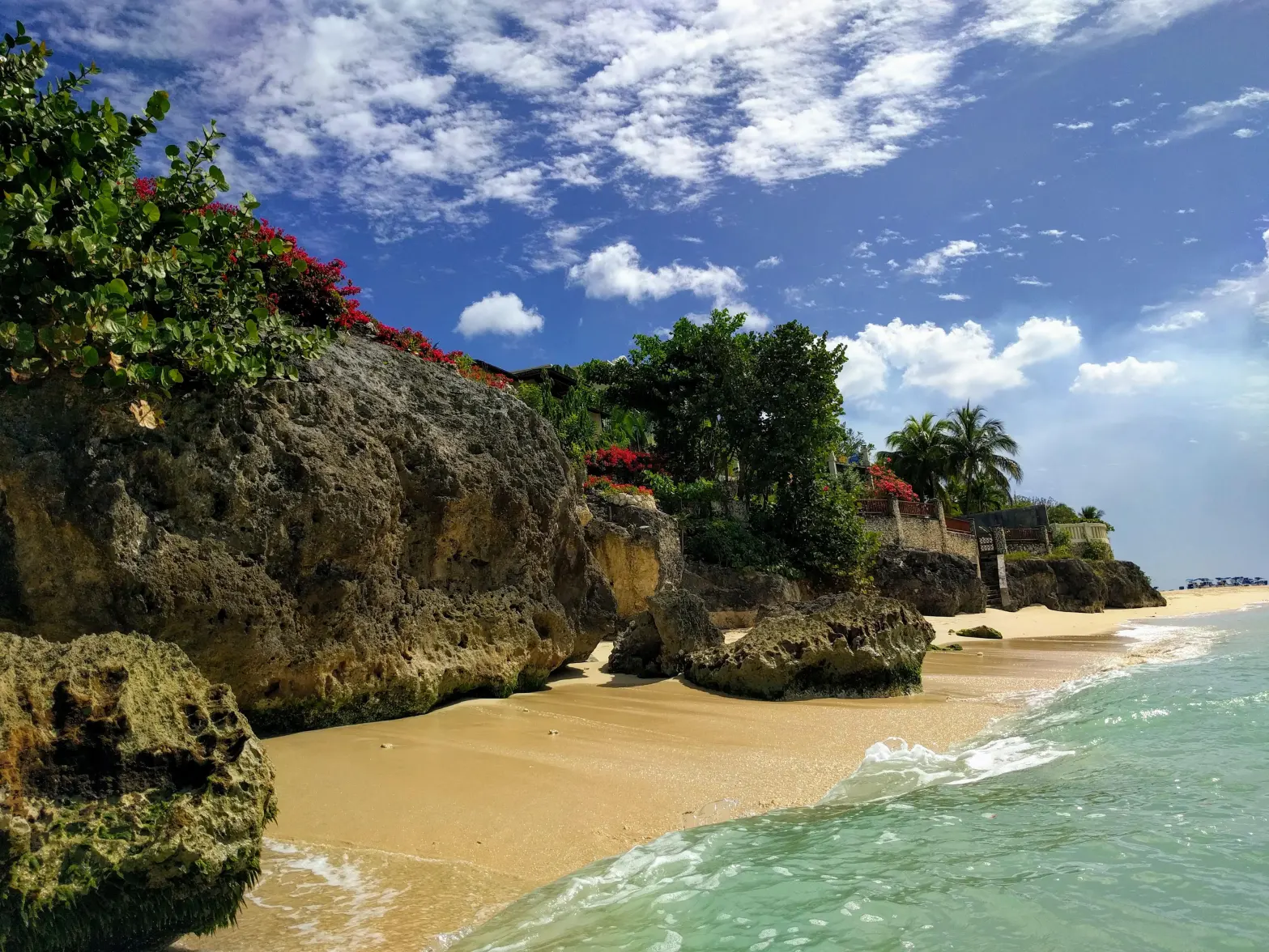
Last updated: February 2022 Originally Posted: February 14, 2019
Barbados is the most easterly island in the Caribbean and populated by about 280,000 people. The island is formed by limestone rocks and measures about 430 square kilometers. Barbados is just north of the equator and far away enough from the hurricane belt that it usually gets spared from them. While less known than other Caribbean destinations, Barbados might be worth a visit. In this post, we talk about the pros and cons about Barbados to help you decide if it’s an island you will enjoy visiting.
COVID-19 Update:
We visited Barbados in February 2022 after they relaxed some of their more extreme COVID-19 measures . To enter Barbados, fully vaccinated visitors needed to submit a negative PCR test and complete a form online. Barbados was very specific to which type of test they accepted and unfortunately, the cheaper NAAT tests were not accepted and it was a challenge to find a PCR test with a quick turnaround time in Vancouver that was relatively affordable; we paid $259 each (usually $299) for a PCR Nasopharyngeal swab with guaranteed results in 16 hours. It was also very confusing to complete the forms required by Barbados in BIM Safe App an the website was often not working. We are still unsure as to what the “hamburger menu” is and that could explain why we received an email on arrival saying that we need to quarantine for 5 days!!! Thankfully that was cleared up when we showed a printed copy of our proof of vaccination as we waited in line for 45 minutes with hundreds of other arriving passengers in a small and poorly ventilated space. Here is a link to the official Barbados COVID-19 travel protocols: https://www.visitbarbados.org/covid-19-travel-guidelines-2022 . We enjoyed visiting Barbados very much but found their protocols and organization to be challenging compared to other places, like Costa Rica or Greece.

Here are the things we like about Barbados:
1) Beaches: Barbados Beaches may not make the top beaches list often but they’re those idyllic white sand and aqua water beaches that everyone dreams about. Compared to other destinations, Barbados beaches are plentiful and easy to access, which means they’re never too crowded. Parking regulations are easy-going so you can easily park somewhere and access many beaches.
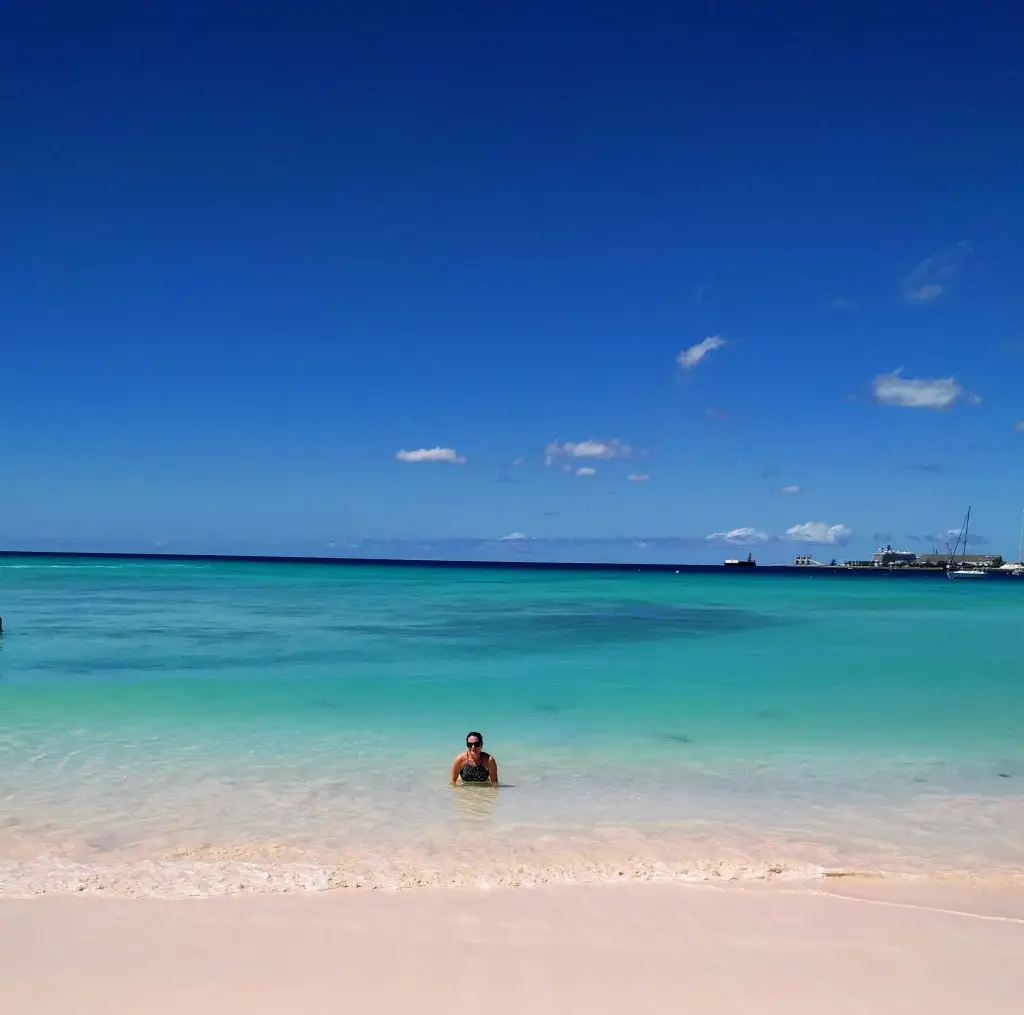
Tip: Bring your own snorkel set and visit Carlisle Bay for some great snorkeling where you will see fish and even sea turtles sometimes.
2) Weather: Sunny days and bright blue skies are generally the norm here outside of hurricane and rainy season. We’ve never had a vacation here ruined due to bad weather and appreciate the consistent weather here. On our last visit last week, it was sunny and +30 Celsius every day.
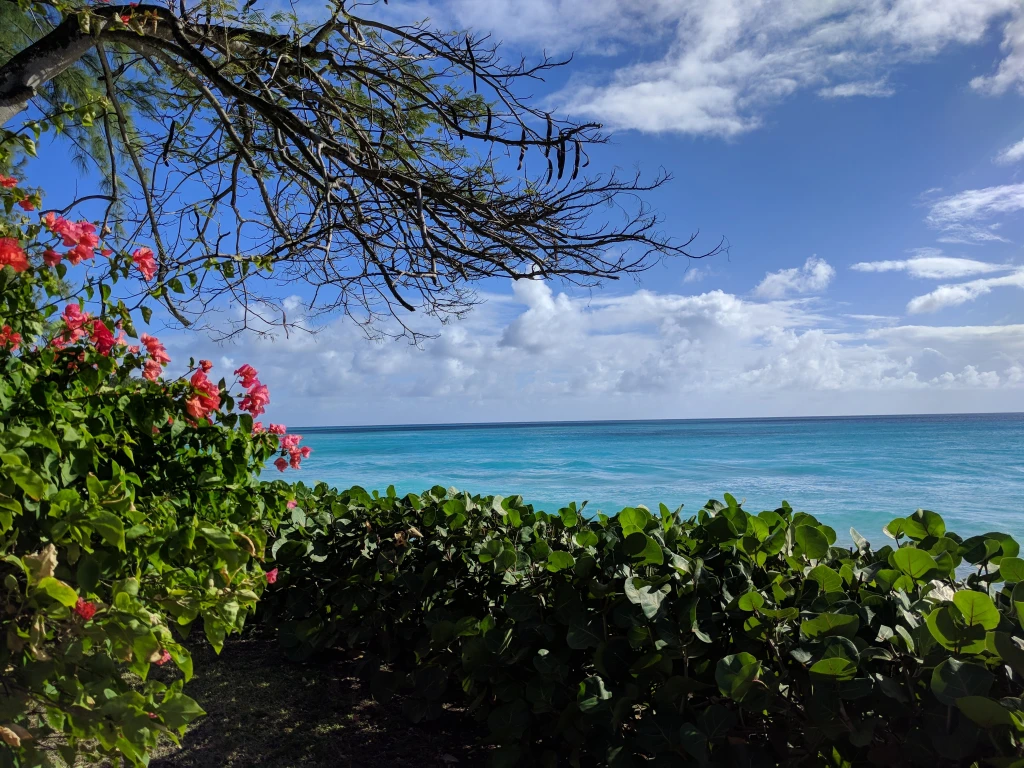
Tip: Wear a rash guard if you plan to swim a lot as the sun is very hot here and sunscreen will not keep you from getting sunburned. Pack an Elaine hat too for maximum protection!
3) Infrastructure: You can drink the tap water and not be as cautious about what you eat as other tropical destinations. As the island is made up of coral limestone, the water is high quality due to natural filtration. You can also rent a car and drive fairly easily on Barbados; just be aware that the driver’s seat is on the right, you drive on the left hand side of the road and need to be mindful of narrow roads, potholes, goats and cows, and intense roundabouts.
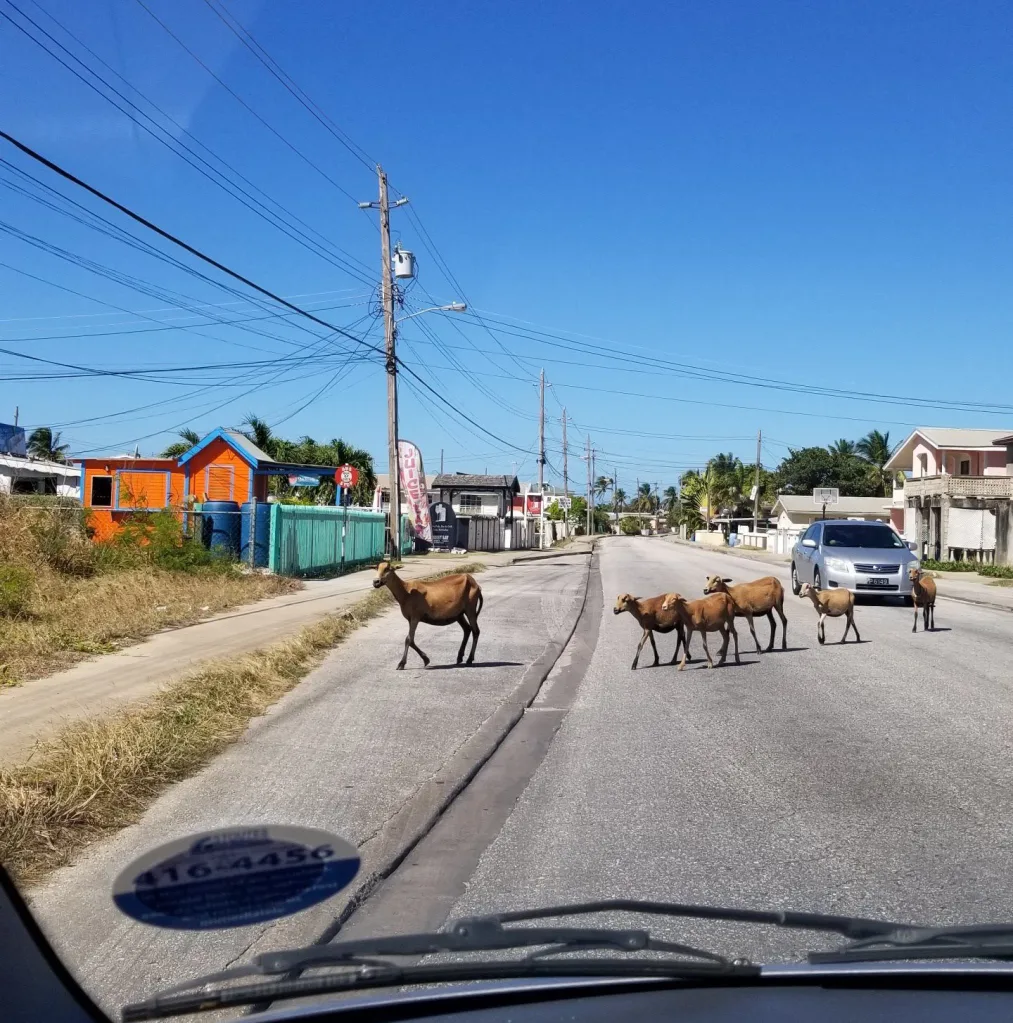
Tip: If you rent a car, buy the additional insurance due to the conditions of the roads and how people drive. Here are some unwritten rules of the road when you’re driving: if someone flashes their lights it means they are letting you go; if someone’s hand is outside the window on the driver’s side they are letting a pedestrian cross; if someone honks once it is because they are passing and if they honk twice it means thank you.
4) Language: English is the spoken language so no need to stress out and learn a new language. Most people speak conventional English but don’t be surprised if you hear the Bajan dialect which is made up of sayings and a slightly different pronunciation of certain letters. Before visiting, you may want to brush up on Bajan to be pompasettin to the locals!
5) Development: Things don’t change that much here so development is limited to protect the environment. Compared to other places like Mexico or Bali, there aren’t massive new hotel projects going up everywhere. Sadly though, many failed projects do remain on prime beach front land. Limited development also means less room inventory which keeps prices high enough and the island from being overrun.
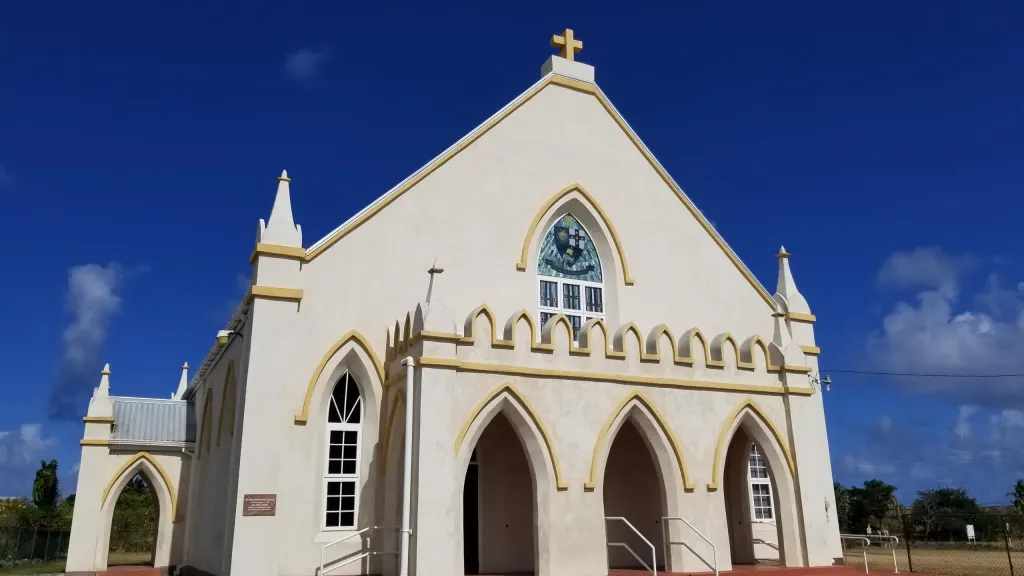
6) Safety: You still need to exercise precautions but Barbados is pretty safe overall in the sense that you can leave your resort or stay in a vacation rental and explore on your own. People will try to sell you drugs in some spots but they’re not too pushy. Violent crime is present but not very common. Locals are also pretty friendly, even after you bust them for trying to scam you, i.e. a man approached us to charge us $10USD to park in a free lot and we called him out on it and he just laughed and walked away. It is also safe, cheap and easy to take the public transit (reggae busses, minivans or government busses) to get around. We do feel it is safe to bring children here for a family vacation and see many people who do.
Tip: If you are visiting the Animal Flower Cave, local people will try to sell you art and souvenirs, if you hand them $1-$2 they will leave you alone and you won’t have to buy anything if you’re not interested.
7) Tourist Attractions: There are numerous tourist attractions like the Harrison Caves, Animal Flower Cave, sporting events (cricket, polo, horse racing), Rihanna’s House, rum distillery tastings and tours, catamaran cruises, snorkel tours, a wildlife reserve, botanical gardens, a plantation tour, Brighton Farmer’s Market and downtown Bridgetown to keep you busy if the beach is not your things.
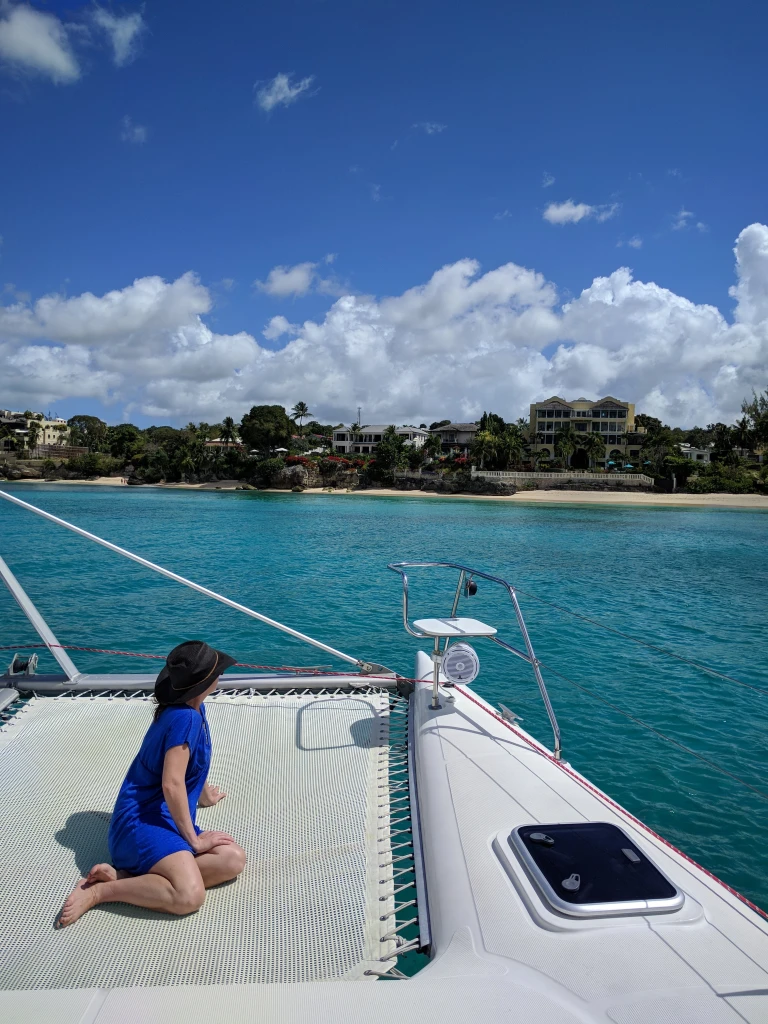
Tip: If you are planning on visiting a rum distillery, we recommend skipping Mt Gay and visiting Foursquare Rum Distillery due to the quality of the rum, the unique setting on an old plantation, and they do not charge for the tour.
No place is perfect though, so here are things we don’t like as much.
1) Airport: The airport can’t absorb all the passengers who arrive within a 3 hour time frame so plan to spend 1+ hours going through customs/immigration. The same can be said when you return to the airport to catch your flight back home; be prepared to wait 1+ hour to each your gate. Flights are outdoor and there are not jet bridges; stairs or a ramp are used which can be challenging for those with limited mobility. Be mindful that Saturdays are the busiest day. We are unsure how this will be now that we are in COVID times but we do consider the lack of clarity and information about the requirements for visitors to be a major con at this time.
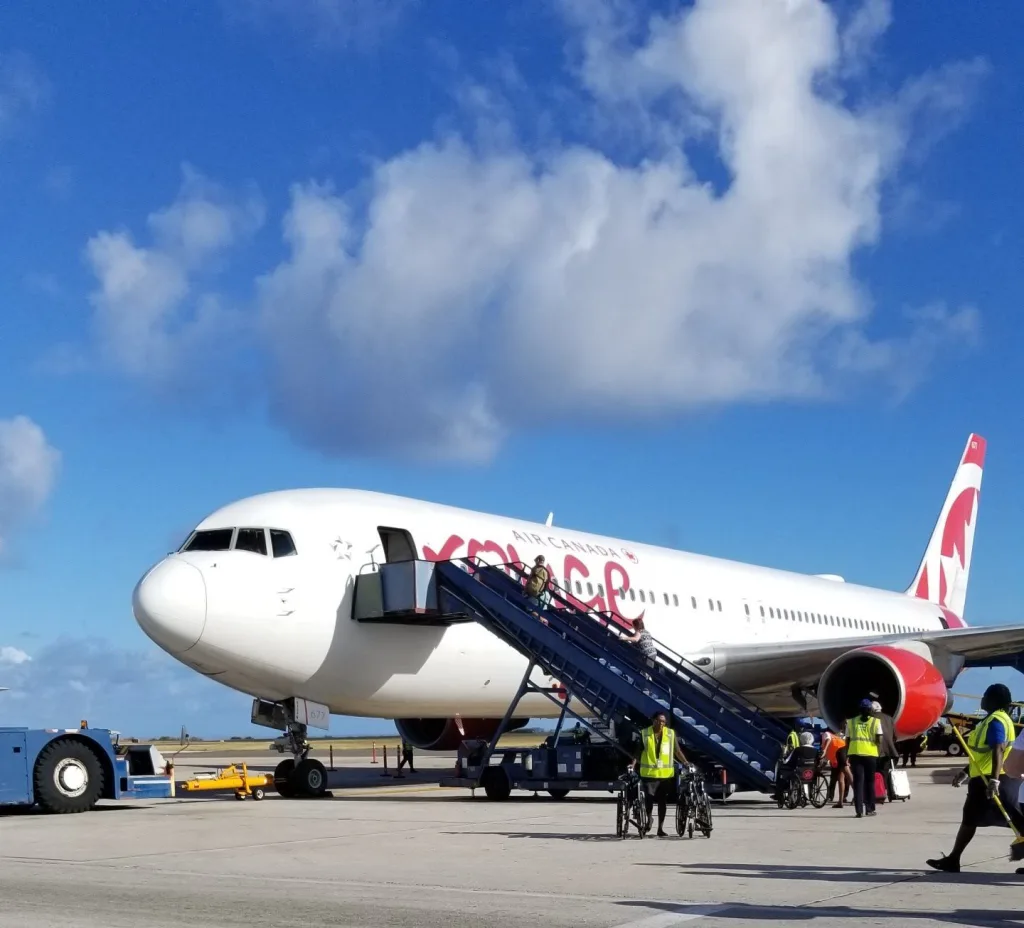
Tip: If you can, fly on the JetBlue red-eye flight from JFK to arrive in the morning and avoid the long lineups. Tip: Each traveler needs to fill out the immigration form and do not lose the bottom part.
2) Budget: You can travel to Barbados on a budget but it’s not as easy as other places due to lack of all-inclusive accommodations and the fact that the local currency, Barbadian Dollar (Bds$) is pegged to the US$. This makes it a lot more expensive for food, accommodations and car rental than other places. There are definitely deals to be had but they’re not as easy to come by. Have a look at our dining guide to avoid spending hundreds of dollars on your meals.
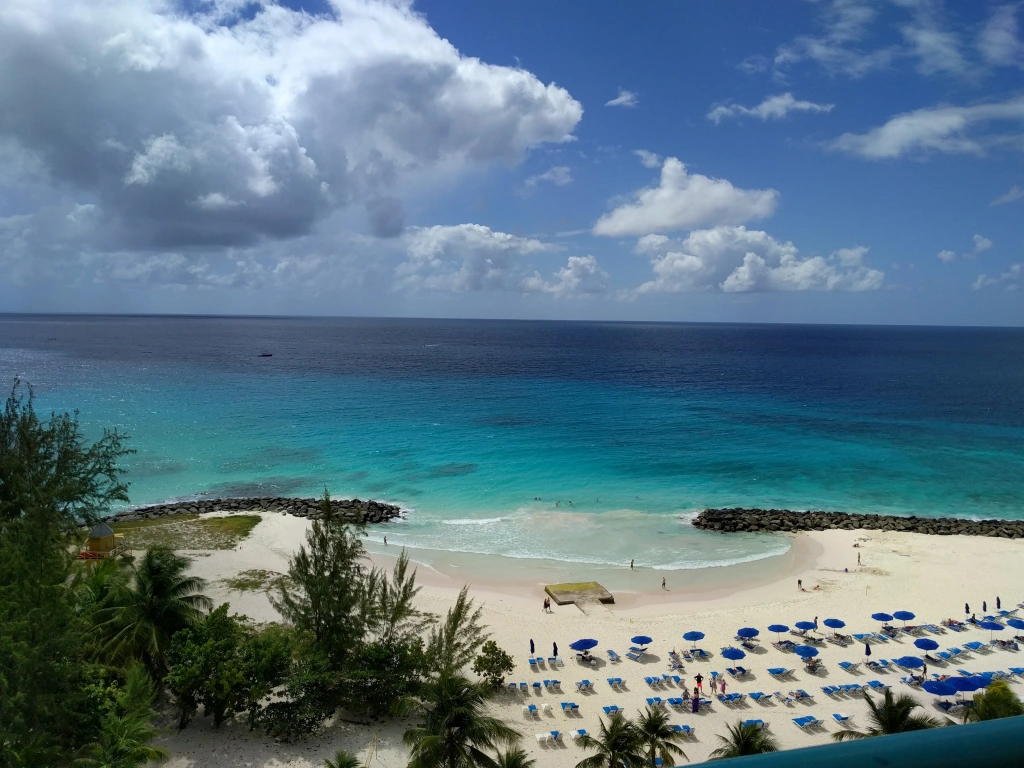
Tip: If you have Hilton points, we recommend using them at the Hilton Barbados . The Hilton Barbados is a 9 story high-rise hotel on a nice stretch of beach and conveniently located to bars, restaurants, and other beaches. If you stay here, you don’t need to rent a car as long as you are comfortable taking a bus or minivan bus.
3) Infrastructure: Infrastructure is better here than other places in the Caribbean but it’s not perfect, I.e recycling, sewage, and potholed roads. There was also an incident with sewage on the beach that prompted travel advisories from the governments in the UK, USD, Germany and Canada.
4) Service: Generally, people are friendly but things run at a different pace here, it’s very slow and don’t expect a lot. In some cases, people aren’t rude but they’re not nice either, i.e. I went back to the grocery store the following day to purchase the item and noticed it was out of stock and asked a store employee if they had anymore and her response was “If you don’t see it, we don’t have it”. Things are supposed to be open and they are not so you just have to go with the flow.
5) Food Scene: Barbados is knows at the culinary capital of the Caribbean and while it is possible to find good food there, we wouldn’t call it a foodie destination. We often find you pay a lot for what you get with varying degrees of quality and consistency, i.e. you can visit the same place 2 days in a row and be charged a different price for the exact same meal that was better the first day. We stick to our favorites, Cuz’s for fish cutters, Chefette for rotis, and Sahara for Middle Eastern food . If there is one thing that has improved in Barbados, it’s the availability of wine at various price points as it used to be very expensive. Now, you can get a decent bottle of rose for about $20USD. A bottle of Veuve Clicquot is usually $75USD as an FYI.
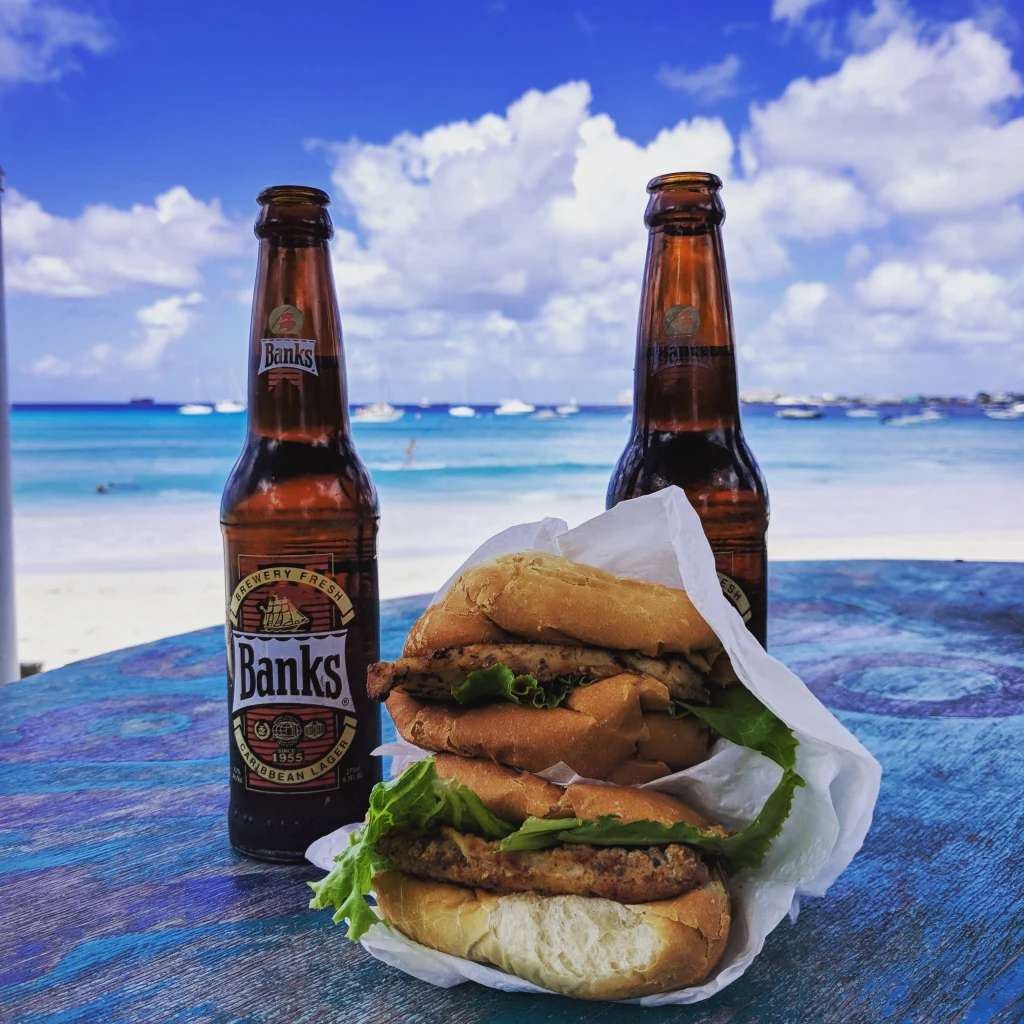
Tip: Make sure to have Barbados Dollars to pay in cash as not all places accept credit card and if they do, often the machine doesn’t work.
6) Tourist Attractions: While there are tourist attractions for those who aren’t into the beach, it’s not a place with lots of hikes or where you can road cycle easily like other destinations. If you don’t rent a car, it will be more difficult to get around depending where you are staying.
7) Beaches: Most beaches in Barbados are fine but some do experience Sargassum seaweed so be mindful of where you choose to stay. Avoid these areas: Crane Beach, Enterprise Beach, Miami Beach and Welches Beach. Stick to beaches north of Dover Beach and especially the West Coast of Barbados.
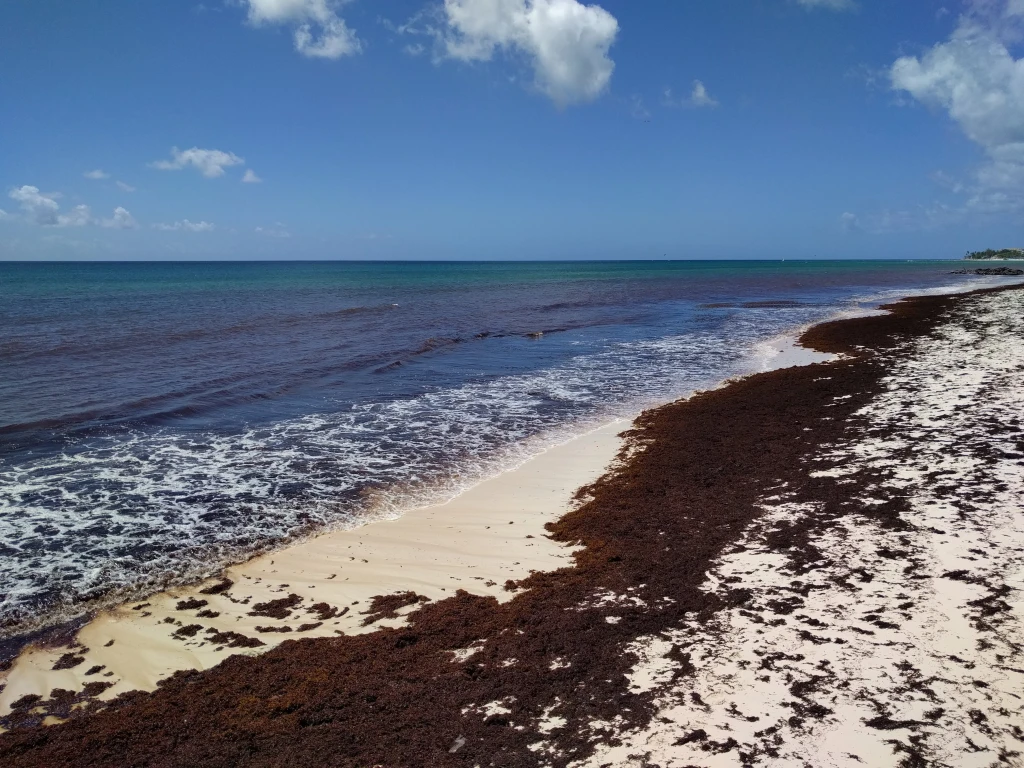
Of all the Caribbean islands we’ve visited, Barbados is our favorite and we’ve been really lucky to visit the island almost yearly since 2012. To be honest, I wasn’t that impressed the first time I visited but over time, Barbados has grown on me and I’ve learned to appreciate it due to the nice weather, the stunning beaches, and the culture. It is always nice to visit the local people we’ve met every year to enjoy the food they make. If all-inclusive isn’t your thing, then Barbados would be a good choice for you as you can explore freely.
Have you been to Barbados? If so, do you agree or disagree with these perspectives? What is the most important factor for you when you’re looking for a tropical vacation? Are there any other questions we can answer about Barbados?
Related Posts:
- Dining Guide for Barbados: Cheap Eats
- Review: The Crane Resort in Barbados
- COVID-19 Protocols for Tourists: 3 Extreme Examples
- Finding and Booking Flight Deals During COVID-19: Good or Bad Idea?
- AAdvantage Miles Expiry Extension and Purchase Miles Promotion During COVID-19
- Our Top 8 Hotel Picks for Socially Distanced Vacations
- Sargassum Seaweed in the Caribbean: Will it ruin my beach vacation?
- 4 Days in Cozumel- A Travel Guide
- Winter Travel Woes: 5 Tips to Mitigate Disasters
- Planning a Hawaiian Vacation: Oahu vs Maui
- Plan: The Maldives on a $500 budget per day
Share this:
One thought on “ visiting barbados: pros and cons ”.
- Pingback: Review: El Vado Motel in Albuquerque New Mexico - WeLeaveToday
Leave a comment Cancel reply

- Already have a WordPress.com account? Log in now.
- Subscribe Subscribed
- Copy shortlink
- Report this content
- View post in Reader
- Manage subscriptions
- Collapse this bar
Please wait while your request is being verified...

- Skip to main content
- Skip to secondary menu
- Skip to primary sidebar
- Skip to footer
Caribbean Development Trends
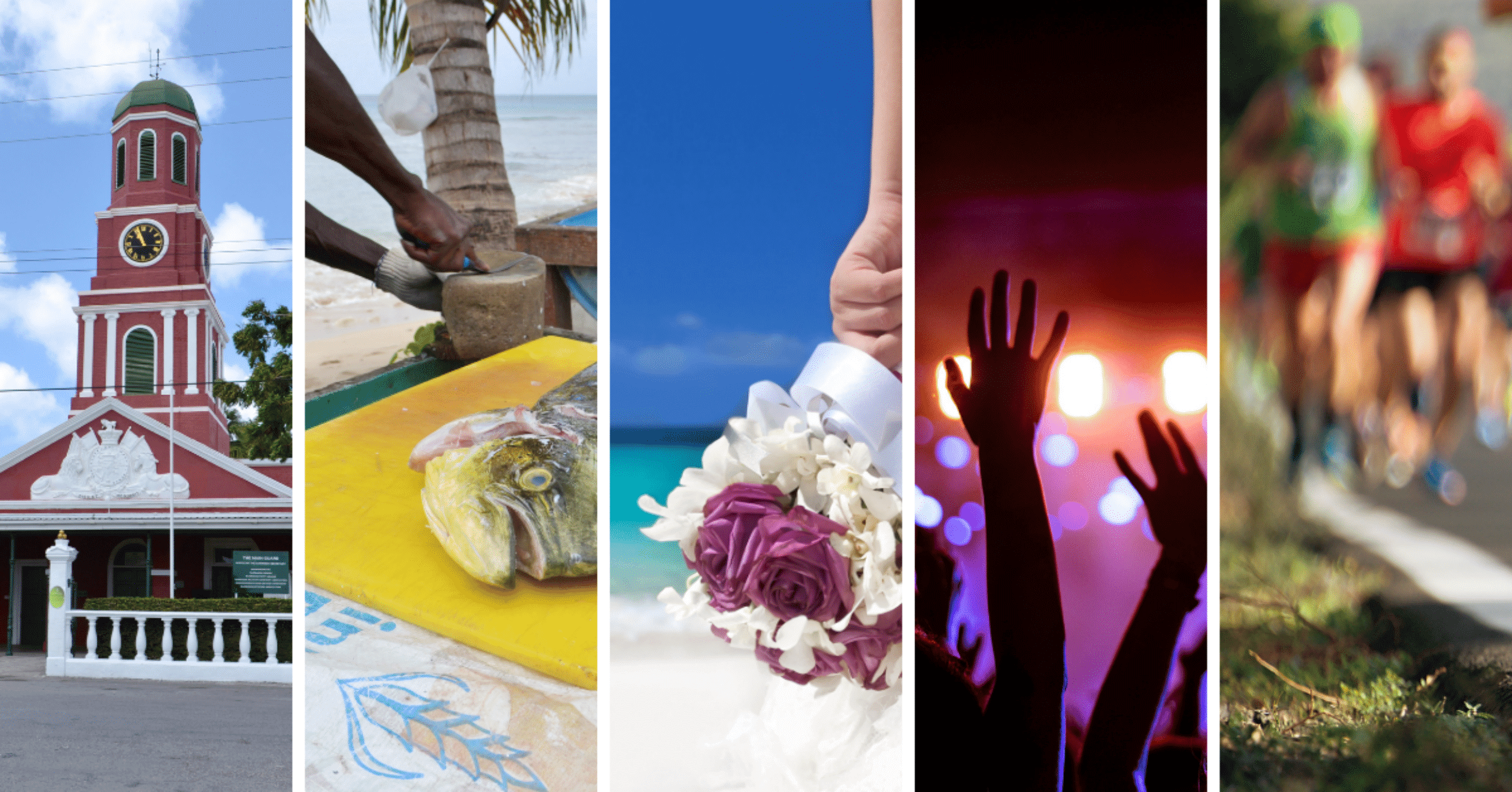
What’s next for Barbados’ tourism industry?
March 27, 2021 by Yajaira Archibald Leave a Comment
Tourism has been one of the sectors most affected by the COVID-19 pandemic. This once-in-a-century event has generated the worst demand shock in tourism’s recorded history. One year into the pandemic, demand for hotel rooms and cruise trips are yet to recover.
In tourism-dependent countries like Barbados, companies are struggling to survive.
The length and depth of this crisis forces policymakers and industry stakeholders to consider not only what to do now, but what to do in the future. Stakeholders want to see a revival of tourism as soon as possible, but they will reap greater benefits in the long-term if this is done in the most sustainable and innovative way possible.
It’s not about building back, but about how the country can build forward better . Barbados acted boldly in its post-Independence period to nurture and sustain a vibrant tourism industry that became the driving force of its economy. Now regarded as one of the Caribbean’s mature destinations with a strong international brand, the country is being challenged to act boldly once more in preparation for the post-pandemic period.
The Barbados Ministry of Tourism and International Transport, in collaboration with the Inter-American Development Bank, confronted tourism’s big questions during the Re-Imagining Tourism in Barbados online consultation March 29 – 31, 2021.
“Resetting a sector that is the central pillar of the national economy seems a daunting task, but it is essential. In some respects, important groundwork has already been laid. The National Tourism Program in Barbados, financed by US$20 million from the IDB, is now poised to be an emblematic project for the country, given its objective of increasing the resilience of the tourism industry,” said IDB Representative in Barbados, Juan Carlos De La Hoz Viñas.
He added, “The IDB remains a strategic partner in accelerating the transition towards a more resilient, sustainable, and innovative tourism sector. Through this important consultation, we continue on this path by creating a space for key stakeholders in Barbados to come together.”
De La Hoz Viñas joined Minister of Tourism and International Transport, Senator the Hon. Lisa Cummins, in welcoming stakeholders to the invitation-only consultation, which brought together participants representing a wide cross-section of businesses – large and small, financiers, civil society, state agencies and institutions and more. They contemplated critical questions on issues such as:
- Travel and tourism trends in COVID-19 times and beyond
- New challenges for tourism investment
- Inclusive, community-led and owned tourism
With keynote presentations by Travel and Tourism Consultant, Douglas Lansky; Miguel Angel Figueroa Calsina, UNWTO Investment Principal; and Founder/President of Countrystyle Community Tourism Network/Villages as Businesses, Diana McIntyre-Pike, participants were inspired and challenged to bring their best ideas and insights as they map out new tourism frontiers.
Barbados is keen for its tourism industry to be reset and reactivated. And this starts by re-imagining all that it could be.
Yajaira Archibald
Yajaira Archibald is the Communications Consultant at the Inter-American Development Bank Barbados Country Office, where she focuses on strategic communications, increasing public awareness of the IDB’s work, as well as building and maintaining dialogue with key stakeholders. Her experience spans the fields of corporate communications, media management, print and digital journalism, and translation. Yajaira holds a Master's degree in Communication for Social and Behaviour Change from The University of the West Indies, Mona and a Master’s degree in Languages with a specialization in Interpreting and Translating from Heriot-Watt University, UK.
Reader Interactions
Leave a reply cancel reply.
Your email address will not be published. Required fields are marked *
Save my name, email, and website in this browser for the next time I comment.

Your Name (required)
Your Email (required)
Your Message
Blog posts written by Bank employees:
Copyright © Inter-American Development Bank ("IDB"). This work is licensed under a Creative Commons IGO 3.0 Attribution-NonCommercial-NoDerivatives. (CC-IGO 3.0 BY-NC-ND) license and may be reproduced with attribution to the IDB and for any non-commercial purpose. No derivative work is allowed. Any dispute related to the use of the works of the IDB that cannot be settled amicably shall be submitted to arbitration pursuant to the UNCITRAL rules. The use of the IDB's name for any purpose other than for attribution, and the use of IDB's logo shall be subject to a separate written license agreement between the IDB and the user and is not authorized as part of this CC- IGO license. Note that link provided above includes additional terms and conditions of the license.
For blogs written by external parties:
For questions concerning copyright for authors that are not IADB employees please complete the contact form for this blog.
The opinions expressed in this blog are those of the authors and do not necessarily reflect the views of the IDB, its Board of Directors, or the countries they represent.
Attribution: in addition to giving attribution to the respective author and copyright owner, as appropriate, we would appreciate if you could include a link that remits back the IDB Blogs website.
Privacy Policy

The Economic Impact of Barbados Tourism
If you’ve ever dreamt of a Caribbean paradise, chances are Barbados was the image in your mind. With its pristine white-sand beaches, azure waters, and year-round sunshine, this island nation is a slice of heaven on Earth. But Barbados tourism isn’t the only economic driver for the island – it’s also a potential goldmine for foreign investors.
So whether you’re an adventure-seeking tourist or a visionary investor, let’s embark on a journey to understand the economic impact of tourism in Barbados.
The Role of Tourism in Barbados’ Economy
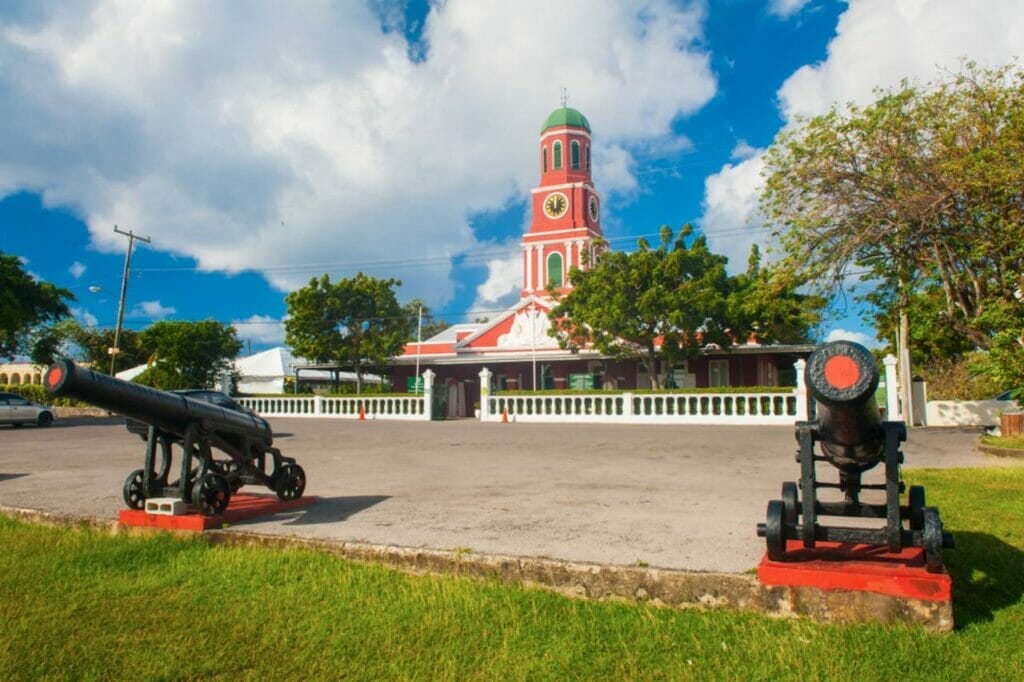
Tourism is the lifeblood of the Barbadian economy. In fact, it accounts for a whopping 40% of the country’s Gross Domestic Product (GDP), and approximately one-third of all employment. This isn’t surprising considering that Barbados welcomes around a million tourists every year.
The beautiful beaches and luxury resorts are like magnets pulling tourists from across the globe. But the island is not just about sun, sand, and sea. Barbados is also home to a UNESCO World Heritage site – the historic Bridgetown and its Garrison, a stunning example of colonial architecture that narrates the fascinating history of this island nation.
The Ripple Effects of Tourism

Tourism is not just about visitor numbers or hotel occupancy rates; its impact ripples through the entire Barbadian economy. Here’s how:
- Foreign Exchange Earnings : Tourism is the primary source of foreign exchange for Barbados. This helps the country pay for essential imports and manage its international debts.
- Job Creation : The tourism industry creates jobs, both directly and indirectly. From hotel staff and tour operators to local artisans selling their crafts, tourism provides livelihoods for thousands of Barbadians.
- Infrastructural Development : The revenue generated from tourism often goes back into developing the island’s infrastructure. This not only benefits the tourists but also improves the quality of life for locals.
Imagine sipping a rum punch at a beach bar.
The rum was locally produced, supporting local agriculture and manufacturing. The bar employs locals and the profits may be invested back into the local community, perhaps towards education or healthcare. This is the power of the tourism multiplier effect in action.
Barbados: An Investor’s Paradise

For investors, Barbados is a land ripe with opportunity. The government actively encourages foreign investment, particularly in sectors that generate foreign exchange or create jobs. Tourism, naturally, is a prime focus.
The investment-friendly climate is bolstered by a stable political environment, a well-educated workforce, and a robust legal system. Additionally, Barbados has tax treaties with several countries, offering tax incentives for foreign investors.
There are opportunities galore in the tourism sector: from hotels and resorts to eco-tourism projects and heritage tourism initiatives. The potential for growth is immense.
Consider the case of the historic Speightstown. Once a bustling port, it has seen a resurgence thanks to investment in heritage tourism. The charming town, with its unique blend of old and new, now attracts tourists keen to explore Barbados beyond its beaches.
The Road Ahead: Sustainable Tourism in Barbados

As we look towards the future, sustainability is the buzzword. Barbados has embraced this ethos wholeheartedly, striving to balance economic growth with environmental preservation.
The island has taken significant strides in promoting eco-tourism. Initiatives like the Future Centre Trust work towards making Barbados a model of environmental sustainability. This not only safeguards the island’s natural beauty but also presents fresh avenues for investment.
For instance, the development of the country’s first ‘green’ hotel, the Eco Lifestyle Lodge, not only caters to a growing segment of environmentally conscious travelers, but also sets a standard for sustainable practices in the tourism industry.
Additionally, the government is encouraging investment in renewable energy, particularly solar power, both to reduce the island’s carbon footprint and to lower its dependence on imported fuel.
Building Paradise: The Infrastructure That Supports Barbados Tourism

Behind the idyllic vistas and sun-soaked beaches, Barbados boasts a robust infrastructure that keeps the tourism industry humming. Transport, accommodation, and services form the backbone of this infrastructure, each a cog in the well-oiled machine that is Barbados’ tourism sector.
Transport : Barbados’ well-maintained road networks, reliable public transportation, and the modern Grantley Adams International Airport make it a breeze for tourists to get around. This ease of access is a key driver of tourist satisfaction, encouraging repeat visits.
Accommodation : From luxury resorts to budget-friendly guesthouses, Barbados offers a range of accommodation options to suit every tourist’s budget. This diversity helps attract a wide spectrum of tourists, from luxury travelers to backpackers.
Services : This includes everything from tour operators and restaurants to wellness centers and dive shops. These services enhance the tourist experience, making their stay memorable.
Each of these sectors not only supports the tourism industry but also contributes significantly to the economy. They create jobs, generate tax revenue, and stimulate local businesses.
For investors, these sectors represent exciting opportunities. Whether it’s developing eco-friendly resorts, setting up boutique tour services, or investing in the culinary scene, the possibilities are endless.
The Tourist Wallet: A Breakdown of Spending in Barbados

The economic value of a tourist in Barbados extends far beyond the confines of their luxury resort. On average, a tourist in Barbados spends around $200 per day, excluding accommodation. This expenditure trickles down into various sectors of the economy, impacting local businesses and individuals.
- Food & Beverage : With a rich culinary tradition that includes flying fish, cou-cou, and the world-famous Barbados rum, tourists spend approximately 30% of their daily budget on local cuisine.
- Transport : Whether it’s hiring a taxi, renting a car, or even taking a local ‘Zed-R’ bus, around 15% of tourist spending goes towards transportation.
- Entertainment & Recreation : From catamaran cruises and submarine tours to heritage site visits and local craft markets, tourists allocate about 25% of their budget to these attractions.
- Shopping : The remaining 30% is typically spent on souvenirs, clothing, and local crafts, supporting local artisans and retailers.
Every dollar spent contributes to the local economy, supporting livelihoods and fostering economic growth.
The Cultural Exchange: Tourism’s Impact on Barbadian Society

Tourism in Barbados isn’t a one-way street; it’s an exchange. Tourists bring with them their cultures, languages, and ideas, influencing the local society. While this cultural exchange can foster understanding and global connections, it can also have some negative impacts.
On the positive side, tourism has led to a resurgence of traditional Barbadian arts and crafts. Artisans find a ready market in tourists keen to take home a piece of Barbadian culture. Similarly, traditional Barbadian music forms like calypso and tuk have found new audiences thanks to tourism.
However, the influx of tourists can sometimes lead to cultural commodification. For instance, the ‘Oistins Fish Fry,’ a once-local event, has become a major tourist attraction. While this brings economic benefits, it also risks diluting the authenticity of this cultural event.
Walking the Tightrope: Tourism and Environment

When one thinks of Barbados, images of pristine beaches and turquoise waters immediately come to mind. However, behind this idyllic picture, there lies a delicate balance between tourism and the environment.
Tourism, while an economic boon, can exert pressure on local ecosystems. High footfall at beaches and marine parks can disturb local wildlife and contribute to pollution. Overfishing to cater to the culinary demands of tourists can disrupt marine life balance. Additionally, high water usage in hotels and resorts can strain the island’s fresh water resources.
Despite these challenges, Barbados has been proactive in tackling them head-on. The government and local communities have embraced the concept of eco-tourism, focusing on sustainable practices. For instance, many resorts now follow water and energy conservation practices, and tours are designed to minimize disturbance to wildlife.
One shining example is the Barbados Sea Turtle Project, which not only works towards the conservation of endangered sea turtles but also educates tourists about their importance. Such initiatives not only protect the environment but also enrich the tourist experience.
Success Stories: Case Studies in Investment
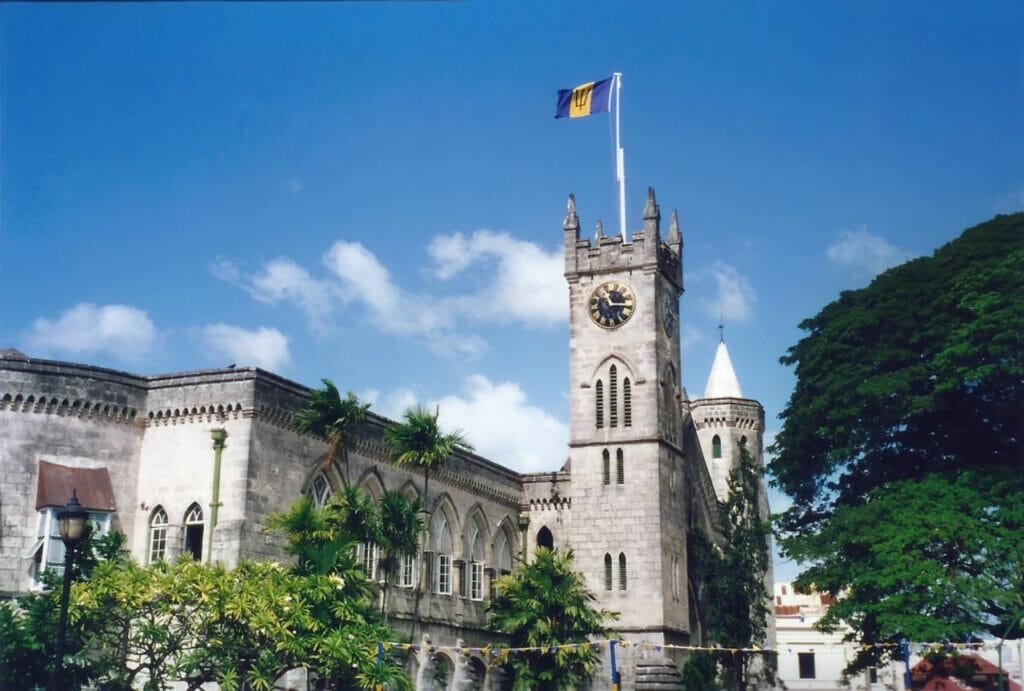
Barbados has seen several successful foreign investments in the tourism sector that have brought mutual benefits. A prime example is the redevelopment of the historic Sam Lord’s Castle into a luxury resort by the Wyndham Hotel Group.
This project not only brought a historic landmark back to life but also created jobs, boosted tourism, and generated economic activity. It’s a testament to how foreign investment can align with local interests to create a win-win situation.
Government Policies: Rolling Out the Red Carpet for Investors

The Barbadian government actively encourages foreign investment in the tourism sector. They have adopted a range of policies and initiatives to facilitate such investment:
- Ease of Doing Business : Barbados ranks high in the Caribbean for its ease of doing business. The government has streamlined procedures, ensuring a smooth process for investors.
- Tax Incentives : Barbados offers tax incentives for foreign investment in the tourism sector, including exemption from import duties and tax holidays.
- Investment Protection : The government guarantees the repatriation of profits and capital, providing a secure environment for investors.
- Support Programs : The government provides support in the form of technical assistance, training, and marketing to foreign investors in the tourism sector.
The Pandemic Pivot: Adapting to the New Normal

Like every other tourist destination, Barbados felt the sting of the COVID-19 pandemic. But in a remarkable demonstration of resilience and innovation, Barbados turned this crisis into an opportunity with its “Barbados Welcome Stamp” initiative.
This program allows foreign nationals to live and work remotely in Barbados for up to a year. Not only did this initiative bring in much-needed revenue during a time of global travel restrictions, but it also introduced a whole new audience to the charms of Barbadian life. For investors, this opens up new avenues for investment in the real estate and digital infrastructure sectors.
The Horizon of Opportunity: Emerging Trends in Global Tourism

As we gaze into the future, it’s clear that the landscape of global tourism is changing. Two trends, in particular, stand out: digital nomadism and wellness tourism. And for Barbados, these trends present exciting opportunities.
Digital Nomadism : The COVID-19 pandemic has ushered in a new era of remote work, giving rise to digital nomads – professionals who work remotely while travelling. Recognizing this trend, Barbados was one of the first countries to introduce a ‘Digital Nomad Visa,’ allowing individuals to live and work in Barbados for up to a year. This not only brings in long-term visitors but also diversifies the tourist demographic, reducing reliance on traditional holidaymakers.
Wellness Tourism : More and more tourists are seeking holidays that enhance their wellbeing – be it physical, mental, or spiritual. Barbados, with its serene beaches, lush landscapes, and warm climate, is perfectly poised to tap into this market. There’s potential for growth in areas like yoga retreats, spa resorts, and nature therapy tours.
For investors, these trends represent new avenues for growth. Imagine investing in a co-working space catering to digital nomads, or a wellness resort offering immersive nature experiences. The possibilities are as abundant as the island’s natural beauty.
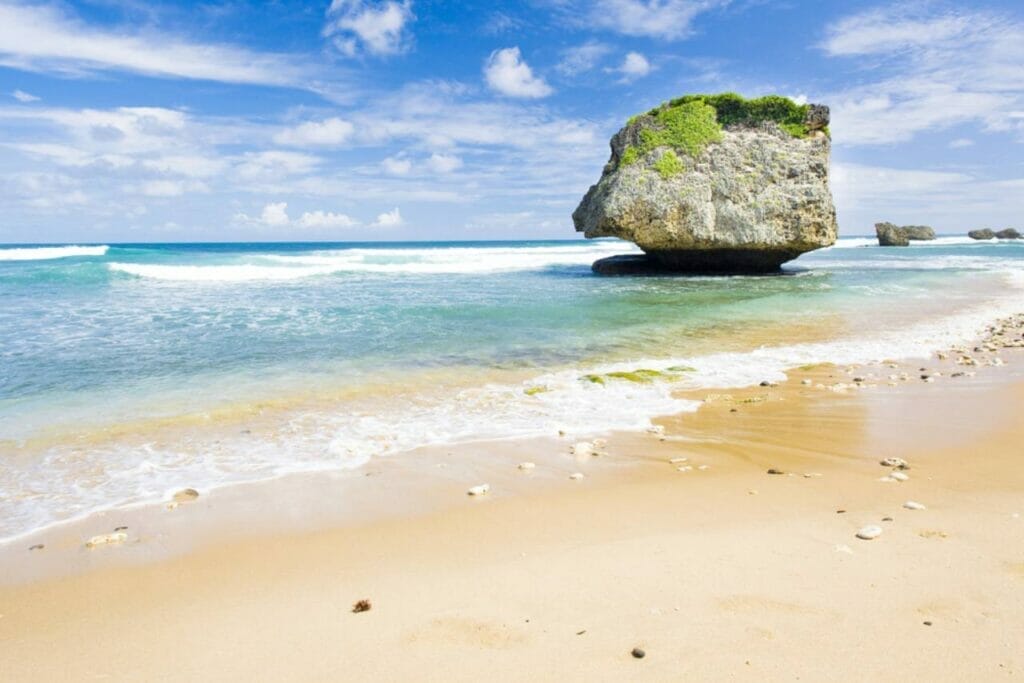
Is Barbados Good For Tourists?
Barbados is an excellent destination for tourists, offering a rich blend of natural beauty, cultural heritage, and hospitality. Its picturesque beaches, vibrant nightlife, diverse culinary scene, and historic sites cater to a variety of tastes and preferences, making it a favorite among travelers worldwide.
Why Is Barbados A Popular Tourist Destination?
Barbados enjoys popularity due to its unique combination of stunning natural landscapes, warm climate, and welcoming culture. The island is renowned for its pristine beaches and crystal-clear waters, perfect for watersports and relaxation. Additionally, its vibrant culture, manifested through music, food, and festivals, offers tourists an immersive experience.
What Is The Value Of Tourism To Barbados?
Tourism is a significant contributor to Barbados’ economy, serving as a primary source of income and employment. It stimulates growth in various sectors, including food and beverage, transportation, and retail. Moreover, the revenue generated from tourism supports infrastructure development and public services, enhancing the quality of life for residents.
What Is The Impact Of Tourism In Barbados?
Tourism in Barbados has a profound impact, both economically and socially. Economically, it drives growth, creates jobs, and boosts local businesses. Socially, it promotes cultural exchange but can also lead to cultural commodification. While tourism brings benefits, managing its impacts is crucial to ensure sustainable development.
What Is Barbados Known For?
Barbados is famed for its breathtaking beaches, world-class rum, and vibrant festivals. The island is home to the historic Garrison Savannah area, a UNESCO World Heritage Site. Barbados is also renowned for its unique music forms, such as calypso and tuk band, and its national dish, cou-cou and flying fish.
Barbados Tourism Conclusion: The Island of Endless Possibilities

As we’ve journeyed through the economic landscape of Barbados, one thing becomes abundantly clear: the island’s appeal extends far beyond its natural beauty. Its thriving tourism sector drives economic growth, creates jobs, and fuels infrastructural development.
For investors, the island offers a stable, investment-friendly environment with plenty of room for growth and innovation. Whether it’s in sustainable tourism, heritage restoration, or digital infrastructure, the opportunities are as abundant as the island’s sunshine.
To the tourists reading this, know that each moment of your vacation contributes to the economic vitality of this beautiful island. To the investors, understand that investing in Barbados is not just about profit; it’s about being part of a story of resilience, innovation, and sustainable growth.
Barbados is not just a paradise for tourists; it’s also a land of opportunity for investors. So come, soak in the sunshine, and be part of the Barbadian dream.
I've been everywhere, man. Crossed the deserts bare, man. I've breathed the mountain air, man. Of travel, I've had my share, man. I've been everywhere!
Leave a Reply Cancel reply
Your email address will not be published. Required fields are marked *
Save my name, email, and website in this browser for the next time I comment.
- Click here - to use the wp menu builder
- E-Magazines
- Entertainment
- Family Notices
- Property Nation
- Accomodation
- TicketNation
- E-Publications
- Smart Homes
- Feature: Owen S. Arthur
- Print Subscription
- Editors Pick

- Tourism still driving Barbados economy
Share post:
Tourism is leading the way as the Barbados economy continues its recovery from the COVID-19 pandemic.
Central Bank Governor Cleviston Haynes reported in his third quarter economic review that the economy grew by 10.1 per cent in the first nine months of this year, including 9.8 per cent growth between July and September alone.
The forecast is for the economy to grow by 10 per cent this year overall, followed by growth between 3.5 per and five per cent in 2023.
But Haynes said predicted slower global economic activity amid the tightening of financial conditions in advanced economies was a threat to Barbados’ prospects.
The Governor said that while economy was not yet producing at pre-pandemic levels, “based on encouraging forward bookings, tourism is expected to sustain its rebound for the remainder of the year”.
Reporting on the tourism performance during a press conference at the Frank Collymore Hall on Wednesday, Haynes said visitor arrivals “continue to be dominated by the traditional source markets, with the United Kingdom leading the way, accounting for 40 per cent of total arrivals and 71 percent of 2019 levels”.
“This outpaced the recovery from the United States and Canada which had arrivals of 56 per cent and 49 per cent of 2019 levels, respectively, for the nine-month period,” he said.
In addition to expanded gross domestic product (GDP), Barbados main economic indicators were inflation of 7.8 per cent, unemployment of 9.3 per cent, international reserves of $2.8 billion, a primary surplus of about $368 million, and gross public sector debt of 126.6 per cent of GDP.
Haynes said that as Barbados’ economic recovery continues, Government needed to “continue its reforms, particularly of state owned enterprises.
“These reforms are intended to improve the quality of service while reducing the burden on the public finances and freeing up resources for needed infrastructural developments and improved resilience to climatic events,” he said.
“Better service quality in the public sector should also contribute to the overall enhancements in productivity and competitiveness in the private sector.” (SC)
- Barbados Nation
- Governor of the Central Bank Cleviston Haynes
- Nation News
- third quarter report 2022

LEAVE A REPLY Cancel reply
Save my name, email, and website in this browser for the next time I comment.
Public schools reopen next week
Met office monitoring dust haze, jamaican cop killed in the line of duty, tennis centre eyeing successive titles, bwa pumping station offline, day of circus magic, related articles.
Each template in our ever growing studio library can be added and moved around within any page effortlessly with one click.
Latest news
Popular news, news corp, australia facebook sign deal, video: babies born in car park, king weds his queen.
Copyright © 1997 - 2023, Nation Publishing Co. Limited • P.O. Box 1203, Fontabelle, St. Michael, BB11000, Barbados, West Indies • All Rights Reserved No unauthorized use is permitted of content produced by NationNews.com, The Nation Newspaper or any other publication or media owned by Nation Publishing Co. Limited. Unauthorized use includes framing and direct posting of content on websites other than www.nationnews.com.
To read this content please select one of the options below:
Please note you do not have access to teaching notes, post-independence challenges for caribbean tourism development: a solution-driven approach through agenda 2030.
Tourism Review
ISSN : 1660-5373
Article publication date: 10 February 2023
Issue publication date: 7 April 2023
This paper aims to provide a comparative analysis of sustainable tourism development across the Anglophone Caribbean region from the post-independence period of 1962 to the 2020s. The perspective explores the implications of insularity, tourism investment and the pace of technology adoption on the potential realisation of the sustainable development goals (SDGs) in the islands of Jamaica, Barbados, Trinidad and Tobago and the Eastern Caribbean States.
Design/methodology/approach
The viewpoint uses secondary data from grey literature such as government policy documents, academic literature, newspapers and consultancy reports to explore the central themes and provide a conceptual framework for the paper.
The findings reveal that Caribbean Small Island Developing States (SIDS) are nearer to the light-green single-sector approach to sustainable tourism development. The overarching findings reveal that the region’s heavy focus on economic priorities results in less attention to competitiveness challenges such as environmental management, social equity and technological innovations.
Research limitations/implications
The research presents a comprehensive overview of the tourism development trajectory of other tourism-dependent island-states. The research offers lessons and cross-learning opportunities that may be useful to decision-makers within SIDS. The main limitation is that the findings may only be transferable and generalised to the extent that other jurisdictions bear similar macroeconomic governance structures and cultural characteristics to Caribbean SIDS.
Practical implications
This paper provides a meaningful discussion and contributes to the body of knowledge on the history of Caribbean tourism development, the challenges and future potential of sustainability and lends itself to opportunities for future research in the Caribbean and other SIDS.
Social implications
The study outlines the social implications for inclusive, responsible and sustainable tourism that can potentially take Caribbean SIDS from slow growth to efficiency in developing the tourism product, including the technological environment. This can reduce inequalities, contribute to socio-economic development and improve the region’s human capital.
Originality/value
This paper provides a comprehensive comparative analysis of Caribbean tourism development specific to Jamaica, Trinidad and Tobago, Barbados and the Eastern Caribbean States. No previous work has been done to compare tourism development within this grouping. Hence, this paper is essential in informing decision-makers and providing the foundation for continuing research in this area.
这篇观点性论文对英语加勒比地区从1962年独立后到本世纪20年代的可持续旅游发展进行了比较分析。该研究前瞻性探讨了牙买加、巴巴多斯、特立尼达和多巴哥以及东加勒比国家的保守性、旅游投资和技术采用速度对潜在实现可持续发展目标的启示。
该研究利用灰色文献中的二手数据, 如政府政策文件、学术文献、报纸和咨询报告, 进行中心主题探索, 并为论文提供概念性框架。
研究结果显示, 加勒比小岛屿发展中国家(SIDS)更接近于以轻绿的单一部门方式实现可持续旅游发展。总体研究结果显示, 该地区过于关注经济优先事项, 导致对环境管理、社会公平和技术创新等竞争力挑战的关注较少。
本研究全面展现了一些依赖旅游发展的岛屿国家的旅游发展路径概览。这项研究为小岛屿发展中国家的决策者提供了可能有用的经验和交叉学习机会。本文研究局限在于, 只有在与加勒比小岛屿发展中国家类似的宏观经济管理结构和文化特征的行政区, 研究结果才可能转移和推广。
这篇论文提供了有意义的讨论, 有助于认知加勒比旅游发展史、可持续发展的挑战和未来潜力, 并为加勒比和其他小岛屿发展中国家的未来研究提供了机会。
该研究概述了包容性、负责任和可持续的旅游发展的社会启示, 这些启示可能使加勒比小岛屿发展中国家从缓慢发展转变为开发旅游产品(包括技术环境)的效率。这有助于减少不平等现象, 促进社会经济发展, 并改善该地区的人力资本。
本文提供了加勒比旅游发展的综合比较分析, 具体到牙买加、特立尼达和多巴哥、巴巴多斯和东加勒比国家。此前没有研究对这些国家的旅游业发展进行比较。因此, 这篇论文为决策者提供必要信息和为这一领域的继续研究建立了基础。
Este trabajo ofrece un análisis comparativo del desarrollo del turismo sostenible en toda la región del Caribe anglófono desde el período posterior a la independencia de 1962 hasta la década de 2020. Se explora las implicaciones de la insularidad, la inversión turística y el ritmo de adopción de la tecnología en la posible realización de los Objetivos de Desarrollo Sostenible (ODS) en las islas de Jamaica, Barbados, Trinidad y Tobago y los Estados del Caribe Oriental.
Diseño/metodología/enfoque
El análisis se basa en datos secundarios bibliográficos a partir de documentos de política gubernamental, literatura académica, periódicos e informes de consultoría para explorar los temas centrales y proporcionar un marco conceptual en este documento.
Conclusiones
Las conclusiones revelan que los pequeños estados insulares en desarrollo (Caribbean Small Island Developing States, SIDS) están más próximos del enfoque del turismo como único sector económico o sostenibilidad débil para el desarrollo del turismo sostenible. Las conclusiones generales revelan que la fuerte concentración de la región en las prioridades económicas hace que se preste menos atención a los retos de la competitividad, como la gestión medioambiental, la equidad social y las innovaciones tecnológicas.
Limitaciones/implicaciones de la investigación
La investigación presenta una visión global de la trayectoria de desarrollo turístico de otros Estados insulares dependientes del turismo. La investigación ofrece lecciones y oportunidades de aprendizaje que pueden ser útiles para los responsables de la toma de decisiones en los SIDS. La principal limitación es que las conclusiones sólo pueden ser transferibles y generalizadas en la medida en que otras jurisdicciones tengan estructuras de gobernanza macroeconómica y características culturales similares a las de los SIDS del Caribe.
Implicaciones practices
Este documento ofrece un análisis significativo y contribuye al conjunto de conocimientos sobre la historia del desarrollo del turismo en el Caribe, los retos y el potencial futuro de la sostenibilidad, y se presta a oportunidades para futuras investigaciones en el Caribe y otros SIDS.
Implicaciones sociales
El estudio esboza las implicaciones sociales del turismo inclusivo, responsable y sostenible que puede llevar a los SIDS del Caribe de un crecimiento lento a la eficiencia en el desarrollo del producto turístico, incluyendo el entorno tecnológico. Esto puede reducir las desigualdades, contribuir al desarrollo socioeconómico y mejorar el capital humano de la región.
Originalidad/valor
Este trabajo proporciona un análisis comparativo exhaustivo del desarrollo del turismo en el Caribe, específico para Jamaica, Trinidad y Tobago, Barbados y los Estados del Caribe Oriental. No se ha realizado ningún trabajo anterior para comparar el desarrollo del turismo dentro de esta agrupación. Por ello, este trabajo es esencial para informar a los responsables de la toma de decisiones y sentar las bases para continuar la investigación en este ámbito.
- Tourism development
- Sustainable tourism
- Responsible tourism
- Agenda 2030
- Desarrollo turístico
- Turismo sostenible
- Turismo responsable
Spencer, A.J. , Lewis-Cameron, A. , Roberts, S. , Walker, T.B. , Watson, B. and McBean, L.M. (2023), "Post-independence challenges for Caribbean tourism development: a solution-driven approach through Agenda 2030", Tourism Review , Vol. 78 No. 2, pp. 580-613. https://doi.org/10.1108/TR-01-2022-0049
Emerald Publishing Limited
Copyright © 2023, Emerald Publishing Limited
Related articles
We’re listening — tell us what you think, something didn’t work….
Report bugs here
All feedback is valuable
Please share your general feedback
Join us on our journey
Platform update page.
Visit emeraldpublishing.com/platformupdate to discover the latest news and updates
Questions & More Information
Answers to the most commonly asked questions here

Tourism in Barbados
Development of the tourism sector in barbados from 1995 to 2021.

Revenues from tourism

All data for Barbados in detail

We’re on the road right now – join in on the fun and follow @thebrokebackpacker on IG!
- Meet the Team
- Work with Us
- Czech Republic
- Netherlands
- Switzerland
- Scandinavia
- Philippines
- South Korea
- New Zealand
- South Africa
- Budget Travel
- Work & Travel
- The Broke Backpacker Manifesto
- Travel Resources
- How to Travel on $10/day
Home » Central America » Travel Safety
Is Barbados Safe for Travel? (Insider Tips)
Barbados is a Caribbean island, rich in culture and has beautiful sceneries. With coral reefs to explore, Barbados is a popular resort getaway and long a favored destination for package tourists and adventurers alike.
Today Barbados is a cosmopolitan country, a nation of beaches that can be visited for its parties and its relaxing credentials alike. With its friendly, warm, and open atmosphere, a visit to Barbados is one that will suit just about any traveller out there.
However, it’s not all paradise in this island nation. Not only is there the threat from mother nature – in the form of hurricanes, especially – but there is also a rise in crime rates and the risk of petty theft and pickpockets in Bridgetown, the country’s capital city.
There is a lot about Barbados that could put you off, but we are here to help you out with this epic guide to staying safe in Barbados. We’re filling it with all the tips and information you’ll need for a safe, secure, and altogether amazing time on this Caribbean island.

Unlock Our GREATEST Travel Secrets!
Sign up for our newsletter and get the best travel tips delivered right to your inbox.
How Safe is Barbados? (Our take)
Is it safe to visit barbados right now, safest places in barbados, 20 top safety tips for traveling to barbados, is barbados safe to travel alone, is barbados safe for solo female travellers, more about safety in barbados , faqs on barbados safety, so, is barbados safe.
Whilst there’s usually no need to worry about any trip to Barbados, that’s not to say that Barbados is without any crime at all.
In fact, there has been a rise in gang-related crimes recently, which often involves guns. There are also warnings for tourists regarding petty crime and scams in the capital, especially.
Tourism is a very important part of the island’s economy. It has been attracting tourists for many years now, with its resorts and luxury getaways.
People are often drawn to this island as it prides itself on being one of the safest in the region, yet crime rates have fluctuated in recent years. There was a worrying spike in the murder rate in 2019, and this is thought to be gang-related.
Luckily, the Royal Barbados Police Force has over 1,000 members; unarmed police patrol high-incident areas, in the hope that tourists will feel safe and protected.
Generally, Barbados is pretty safe. But to get into the details of what makes Barbados ticks, let’s take a look at the vital statistics…
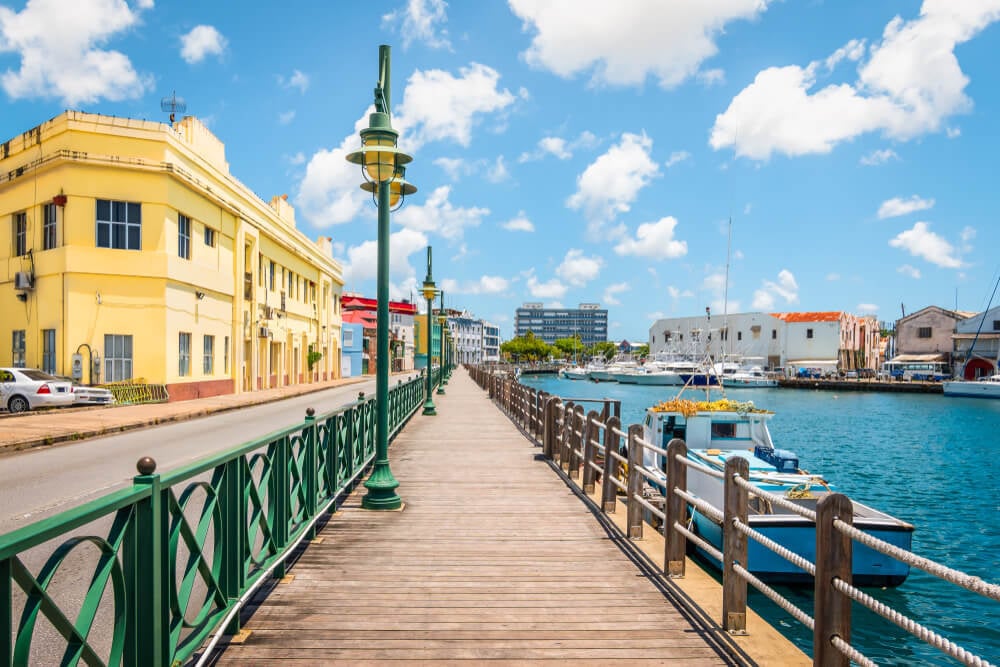
There is no such thing as a perfect safety guide, and this article is no different. The question of “Is Barbados Safe?” will ALWAYS have a different answer depending on the parties involved. But this article is written for savvy travellers from the perspective of savvy travellers.
The information present in this safety guide was accurate at the time of writing, however, the world is a changeable place, now more than ever. Between the pandemic, ever-worsening cultural division, and a click-hungry media, it can be hard to maintain what is truth and what is sensationalism.
Here, you will find safety knowledge and advice for travelling Barbados. It won’t be down to the wire cutting edge info on the most current events, but it is layered in the expertise of veteran travellers. If you use our guide, do your own research, and practise common sense, you will have a safe trip to Barbados.
If you see any outdated information in this guide, we would really appreciate it if you could reach out in the comments below. We strive to provide the most relevant travel information on the web and always appreciate input from our readers (nicely, please!). Otherwise, thanks for your ear and stay safe!
It’s a wild world out there. But it’s pretty damn special too. 🙂
As we’ve mentioned already, the crime rate of Barbados has been slowly rising in recent years. While this could be worrying, it is mainly an issue between gangs and violent crime is unlikely to affect any visitors to the country.
Pickpockets in Bridgetown can be an issue for tourists. Currently, the areas around Swan and Broad Streets are known for their scams and pickpockets, as is St Lawrence Gap.
Natural and seasonal issues, on the other hand, could pose even more of a risk to tourists.
The hurricane season in the Caribbean runs from June to November. During this time, Barbados could be hit by the strong winds and heavy rains that a hurricane brings. The U.S. National Hurricane Centre ( nhc.noaa.gov ) monitors international weather, and is a good place to check for evacuation orders and other information.
Another natural threat is the underwater volcano, Kick’em Jenny, which is just 5 miles off the coast of Grenada. It’s important to pay attention to any increased activity or eruptions, as these could affect Barbados. Similarly, earthquakes do affect the Caribbean and are a potential threat to visitors’ safety in Barbados.
Zika virus and dengue fever are also currently a threat in Barbados; these, as well as Chikungunya virus , are spread by mosquitoes, so it is important to take steps to avoid being bitten.
With all this in mind, you might think that it’s not safe to visit Barbados right now, but it’s the exact opposite. As long as you use your travel common sense and stick to the local rules, you’ll have a perfectly safe trip to Barbados.
Some places in Barbados are safer than others. However, we do have to say that you’ll be absolutely fine in pretty much all parts of the island, as long as you use your common travel sense. To make planning a bit easier, we’ve listed the three safest areas to stay in Barbados.
Of the South Barbados resorts, Oistins is one of the most laid-back and safest. Here you will find both tourists and locals mingling and enjoying the colourful décor in the street. For a first time traveller, Oistins is a great way to ease yourself into the destination. The beach is also a little more peaceful than the larger resorts. You can find a few highly reviewed tour companies here that will help you explore the island safely.
Speightstown
Speightstown is right at the end of the highway connecting Western Barbados with Bridgetown. It’s a bit more upmarket and more expensive than other neighborhoods, but it also offers more safety. With exclusivity comes peace and quiet, making this a firm favourite with families visiting the area.
Bathsheba is located on the east coast. It’s not a single city, but more like an area with loads of charming little villages. It’s quite off-the-beaten-path, but hardly sees any crimes. If you want a real adventure and to get to know the local culture, Bathsheba is a great place to start. There are less tourist resorts here as well, so you might even score a welcoming guest house instead.
Places to avoid in Barbados:
While most places on the island are pretty much safe, there are definitely some areas that you should avoid. Most pickpocketing is being recorded around the popular sights, so keep an eye open. Apart from that, crime rates in the capital city Bridgetown are the highest in Barbados. Note that the city is generally safe, but has a few sketchy areas. Here are the main places you should avoid:
- Any dark and secluded side street – especially at night
- Crab Hill – at all times
- Nelson – at night
- Wellington Streets – at night
Staying away from these areas will add another level of safety to your trip. That being said, always make sure to stay aware of your surroundings, no matter where you are.
Barbados Travel Insurance
ALWAYS sort out your backpacker insurance before your trip. There’s plenty to choose from in that department, but a good place to start is Safety Wing .
They offer month-to-month payments, no lock-in contracts, and require absolutely no itineraries: that’s the exact kind of insurance long-term travellers and digital nomads need.

SafetyWing is cheap, easy, and admin-free: just sign up lickety-split so you can get back to it!
Click the button below to learn more about SafetyWing’s setup or read our insider review for the full tasty scoop.
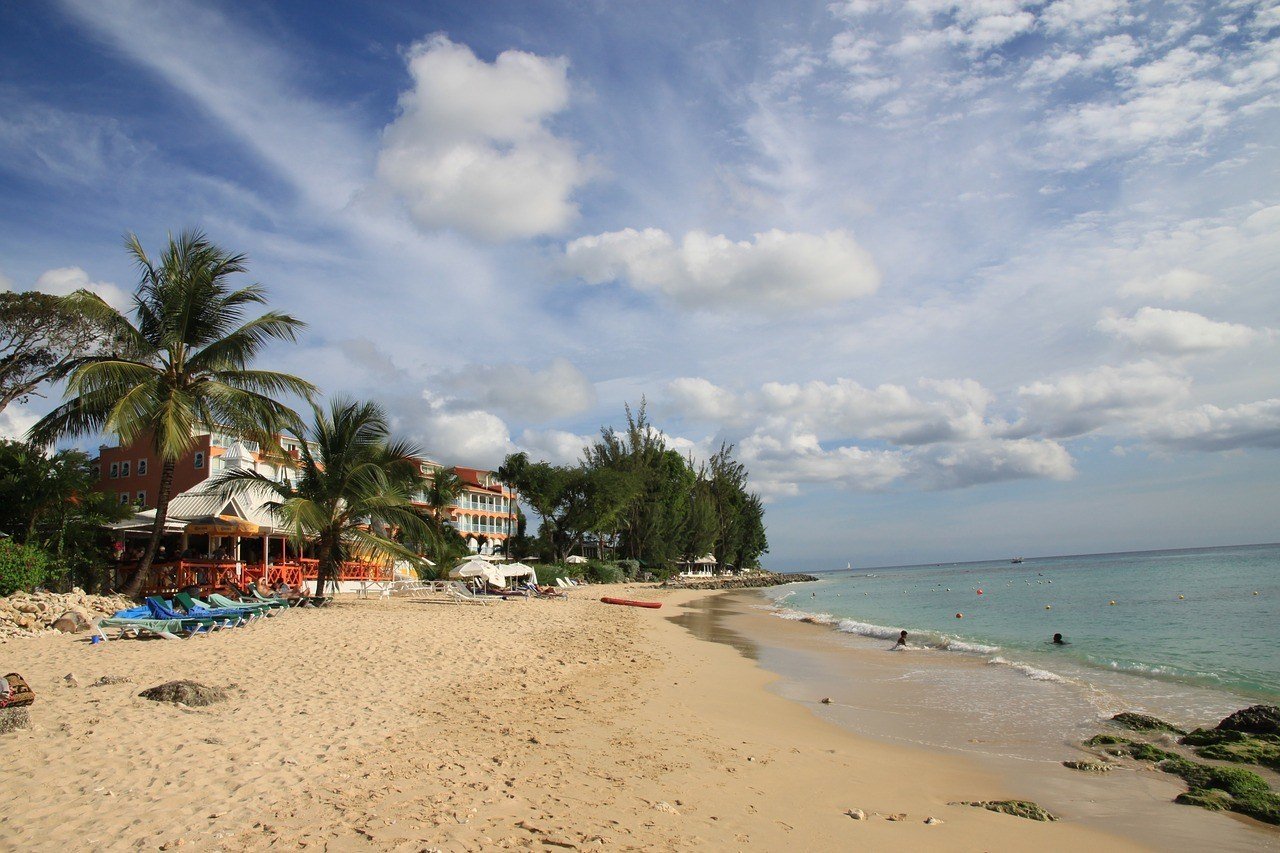
Barbados is a safe island to visit that also happens to be very fun, too. However, that isn’t to say that Barbados is a theme park; this is nevertheless a real country where things could happen if you are not careful. To ensure that you stay as safe as possible, we have decided to share with you some of our best safety tips for travelling to Barbados.
- Be careful withdrawing money from ATMs – Make sure you do so in a safe, not isolated, area busy with people; avoid doing this after dark. Use a moneybelt to keep your cash secure.
- Don’t walk around in isolated areas alone – This includes beaches and areas away from busy main roads, and especially at night.
- Don’t carry around valuables with you – Things like smartphones, expensive electronics and SLRs will make you stand out like a potential target to thieves. To be on the safe side, leave them at home.
- Pay particular care to wearing “visible gold jewellery” – Local police have specifically warned against this, both for residents and visitors, and goes for Bridgetown and other popular tourist spots.
- Only take licensed taxis – More on this later, but this is a good way to put yourself at risk.
- Be careful during festival season – These big parties can also attract opportunist thieves, so be vigilant.
- Be very careful when you’re swimming – The currents can be really strong; even popular tourist beaches on the south and west coast can be hazardous to swimmers (people have drowned).
- Don’t swim at east coast beaches – Currents here are particularly strong; look-up local warnings and obey them.
- Do not get involved in drugs – There are severe penalties for any and all drug offenses
- Leave your camouflage clothing at home – It is actually an offense for adults, and children, to dress in camouflage
- Cover up against mosquitoes – There are several mosquito-borne diseases in Barbados, so covering up, using DEET, avoiding stagnant/still water – all especially at dawn and dusk, when mosquitoes are most active – is important
- Stay aware of the weather forecasts – Paying attention to the weather means not suddenly finding yourself stranded in a hurricane; pay particular attention from June to November (hurricane season).
- Know that earthquakes can affect Barbados – You should research what to do before, during and after an earthquake and heed local advice
- Don’t leave belongings unattended – Whether this be lying around your hotel room, on show in your car, or left on the beach as you swim, it’s not a good ide..
- Keep your room secure – There are some amazing places to stay in Barbados , just remember to lock windows, doors and use the room safe or hotel safe if there is one.
- Stay away from the manchineel trees – You’ll find these on some beaches. The fruit is poisonous but even the sap, which can drip on you, can cause blisters. They are usually marked by red spray paint
- Be culturally aware – It’s important to understand more about the country you’re visiting before you arrive, so do some research
- Report crimes and scams to your hotel – If anyone has been hassling you or trying to scam you, the police – or your hotel – will be able to deal with it
- Get yourself a sim card – It’s helpful for getting around and keeping in touch with people
- Dress down – Looking like a wealthy tourist, especially if venturing out of resort areas, may single you out as a target
For the most part, Barbados is safe. It is not exactly a country that we would deem dangerous. Like everywhere in the world, however, there can be risks. Don’t do anything you wouldn’t do at home, basically.
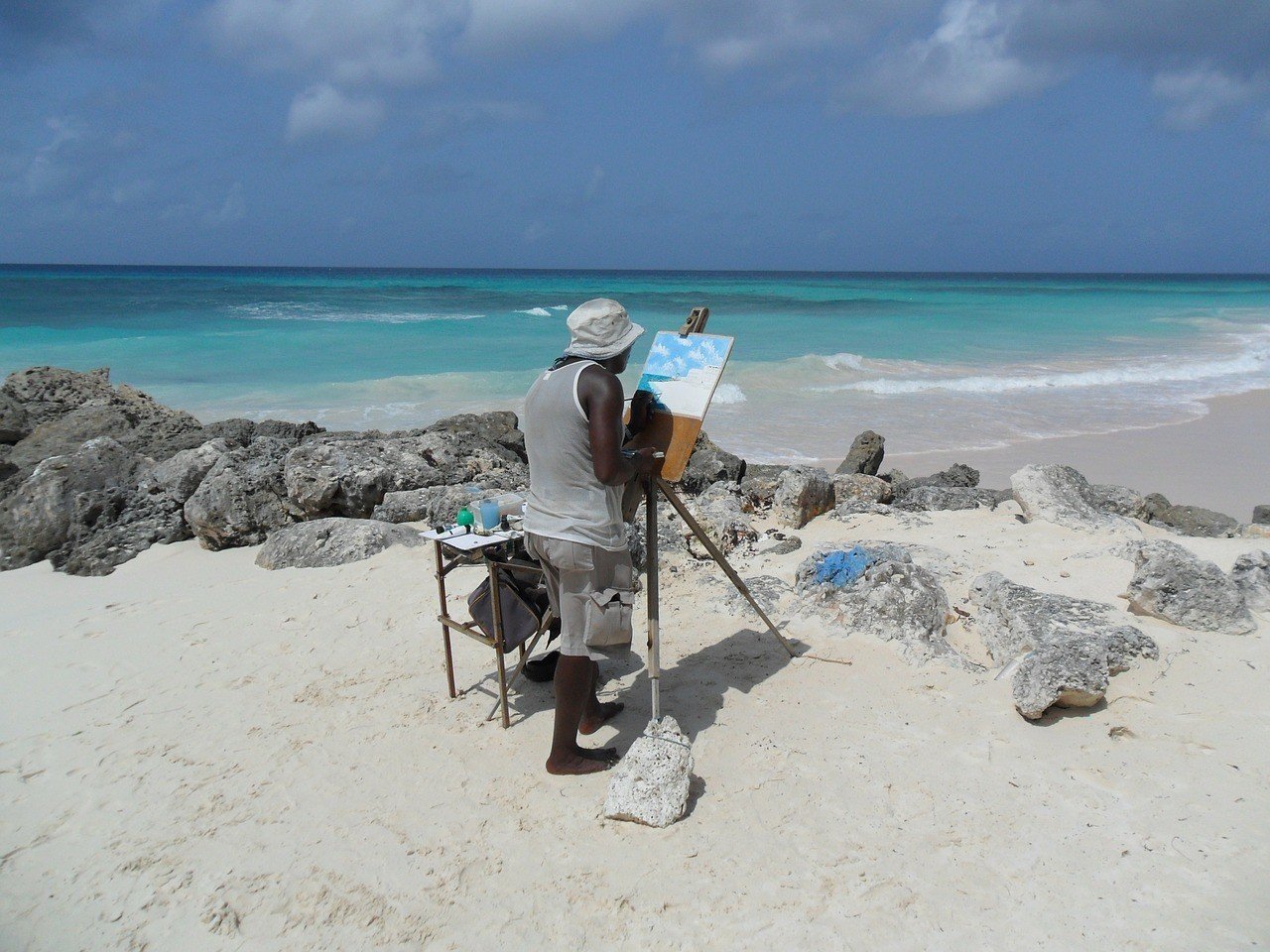
If you’re thinking about travelling solo in Barbados, you should do it. More and more people are heading by themselves to this Caribbean destination, finding time to relax on its sandy beaches, exploring its magnificent nature, or hitting the surf.
We’ve compiled a few pointers to help you stay safe and secure when you solo travel in Barbados.
- It is important to do your research about the area in which you’re thinking about staying. Though generally safe, finding the right area in Barbados that suits you is something you should really spend some time doing.
- Plan some activities . This way you will be able to get out and enjoy Barbados, but without the onus on yourself to explore and learn about everything by yourself. Again, however, you need to ensure that you research guides and tour companies thoroughly.
- That said, you shouldn’t do too much. Leave space in your schedule for downtime – days when you can just chill out on the beach and hang around your resort pampering yourself.
- Don’t go completely off-grid. Solo travel doesn’t mean that you have to cut off contact with everyone back home. Take time to keep in touch with your friends and family ; this will help keep you grounded, stave off homesickness, and also means that people know your whereabouts.
- It’s not a good idea to walk around by yourself in isolated areas. Being by yourself in quiet areas could really lead to you becoming a victim of crime, so find a travelling buddy to explore the island with or opt for tours when it comes to Barbados’ less trodden routes.
- If you are going out exploring by yourself, however, you should really tell somebody where you are going . It’s much safer having someone know where you’re going and what you’re doing.
- Ask at your hotel or a local, if there are places you should be avoiding. Likewise, you should ask if there hidden gems you should be seeing that would really enrich your trip.
- Travel as light as possible ; it will also be much more comfortable that way if you plan to hop around the island.
- Have emergency contacts saved in your phone and have them written on a piece of paper, in case your phone runs out of juice.
- Speaking of which, you should keep your phone charged at all times – in case of emergencies.
- If you do decide to go out by yourself though, don’t drink too much . The risks of drinking way too much far outweigh the benefits, and can easily lead to poor decision-making, putting yourself in unsafe situations, or simply being unable to find your way home.
This idyllic island is actually quite a haven for solo travellers. Not only is there a laid-back lifestyle, but there is also a lot on offer for many different types of traveller.
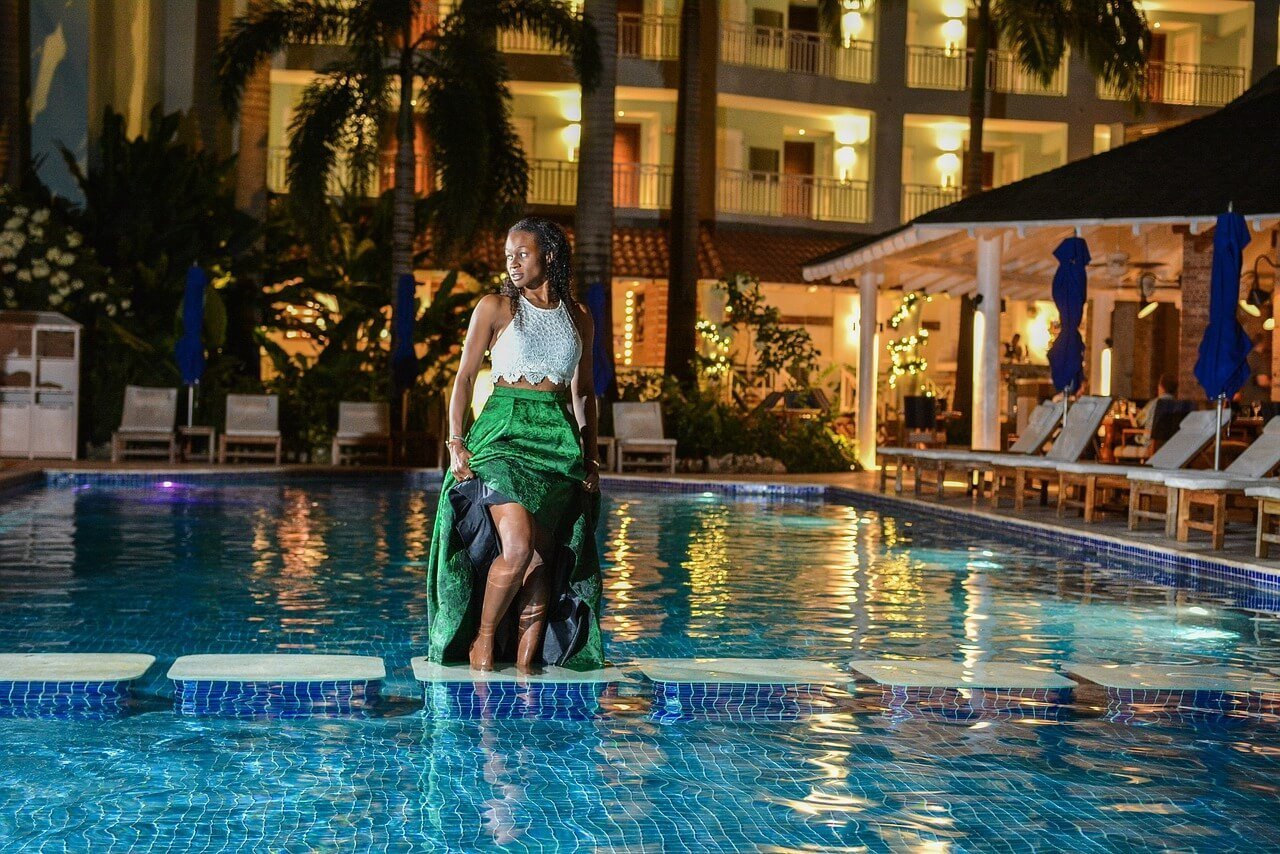
Barbados may not be on the top of every solo female travellers’ wish-list. There are the romancing couples, the high-priced resorts, the well-trodden nature of the island in general and a lack of other women travelling by themselves in Barbados.
However, none of that means that it’s not safe to travel to Barbados as a solo female.
In fact, it can be done quite easily – and we have some curated tips for solo female travellers in Barbados that will walk you through just how you can go about it (and stay safe in the meantime)…
- Research your accommodation and book very carefully. Pay special attention to reviews left by solo female travellers, and only opt to stay at places that have been favourably reviewed by other women.
- You shouldn’t feel that staying at an all-inclusive resort is a cop-out ; this is a safe option and a good one for women travelling by themselves for the first time especially.
- Be careful with going out partying by yourself . If you want to go out and enjoy the nightlife that Barbados has to offer, it’s best to gather a group of people together or go on an organised bar crawl or tour.
- Ignore any over-the-top attention you may receive from men on the street; it’s not a good idea to react in any way, just keep moving.
- Walk around confidently with your head up. Looking lost or vulnerable could lead to you being more of a target, so be confident and act like you know where you’re going – even if you don’t.
- Dressing down, or dressing casually , and being aware of how what you’re wearing is fitting in with the surrounding environment, is something to think about.
- Don’t be afraid to ask for help . Whether it’s from the police or local people, most people are very friendly and will be happy to help you with directions or anything you may ask for.
- Be very careful if you are going out somewhere isolated. Even if you want to just go out for a jog from the apartment you’re staying at, it’s important to note that the quiet areas are riskier for people by themselves, especially women.
- Know where you’re heading . Simply going for a wander may put you at risk or lead you into a bad situation.
- Meet up with local ladies or other travellers by getting involved in online forums before you go and Facebook groups like Host A Sister.
- Tell close people where you are . This is very important; just like any destination in the world, it is crucial that somebody you trust knows where you are and what you are doing at all times.
- Be careful during busy times, like Crop Over Festival, when there are lots of people partying and getting drunk. Make sure to watch your drink .
Though it may not seem like it, considering the lack of hostels with female-only dorms and things like that, Barbados is a fine place to travel solo as a woman.
Like anywhere in the world, however, being a lone female traveller comes with more risk than it does for your male counterparts. Although you can keep your wits about you, like you would do at home, it’s always different in a new country.
We’ve already covered the three main questions, but there is loads more to know about safety in Barbados. Read on for more detailed information on how to have a safe trip to Barbados.

Is Barbados safe to travel for families?
Barbados is a brilliant place for a family holiday. With all those resorts, villas, condos and mid-range hotels, there is a huge selection of family-friendly accommodation on offer across the island – a good place to start.
While it is true that it is not always the cheapest place to travel, especially if you have children with you, Barbados is nevertheless a family-friendly destination.
However, it is important to note that not all accommodation is set up with children in mind; some resorts and hotels will be adult-only and won’t accept children.
For beach days, most beaches around the island are safe for playing on. However, not all are safe for swimming. Only swim where there are lifeguards around. The east coast is not a good idea for novice swimmers and children, as the offshore currents are strong.
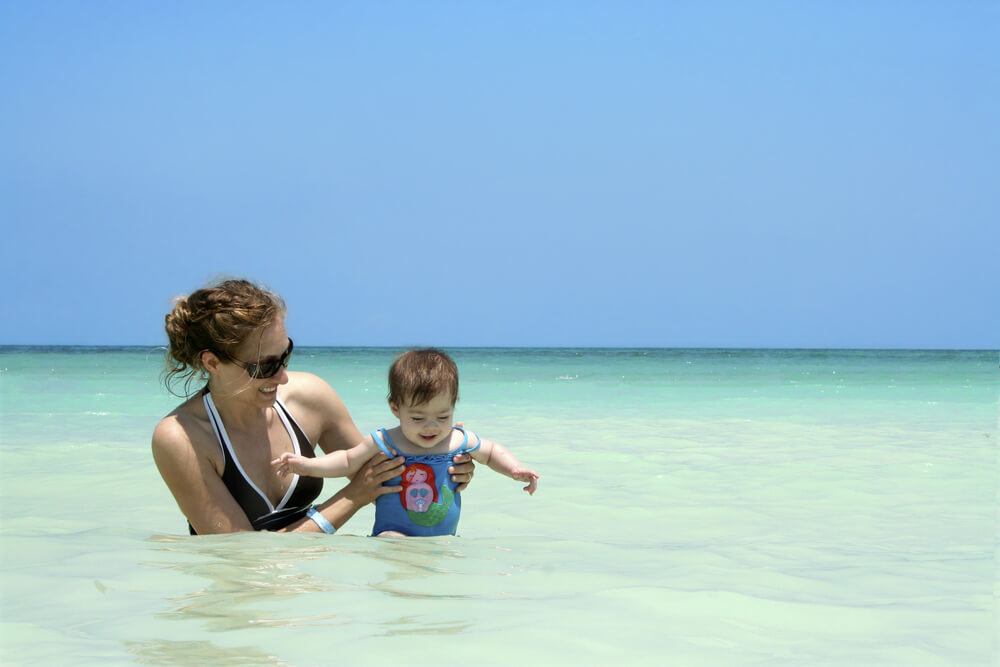
The nature of Barbados can be something of a menace when you plan on visiting with children.
First of all, mosquitoes can be more than just a bother, but can be dangerous for children; avoid you and your family getting bitten by covering up and using repellent.
Exposure to the sun can be brutal as well, especially to small children. Limit your time in the sun – this goes doubly for when the sun’s at its hottest after around midday – and definitely apply sunscreen, cover up with T-shirts and wear sun-hats.
When it comes to weather, when you visit Barbados is something to consider. November, for example, is known as shoulder-season; it’s not hurricane season, it’s still warm – but blazingly hot – and prices will be cheaper.
Is it safe to drive in Barbados?
While it is safe to drive in Barbados in general, drivers should certainly take care in doing so. It isn’t all easygoing, but the experience of driving abroad is something that we very much recommend.
Driving in Barbados can be confusing, especially in the countryside. The highways aren’t very clearly marked, so it’s easy to miss your turning. Expect to be going off things like landmarks as opposed to consistent highway markings and signage.
Secondary roads are usually paved, but not always, and in rural areas, they can be very narrow with blind corners to look out for. It’s a good idea to have a physical map with you, as well as your smartphone GPS, to help you get around. That said, a friendly local will probably be able to help you if you do get lost.
It’s not a good idea to stop if a pedestrian is trying to flag you down – to be on the safe side. When you are driving, keep your car doors locked; anything valuable should be out of sight, and reach, of any potential break-ins.
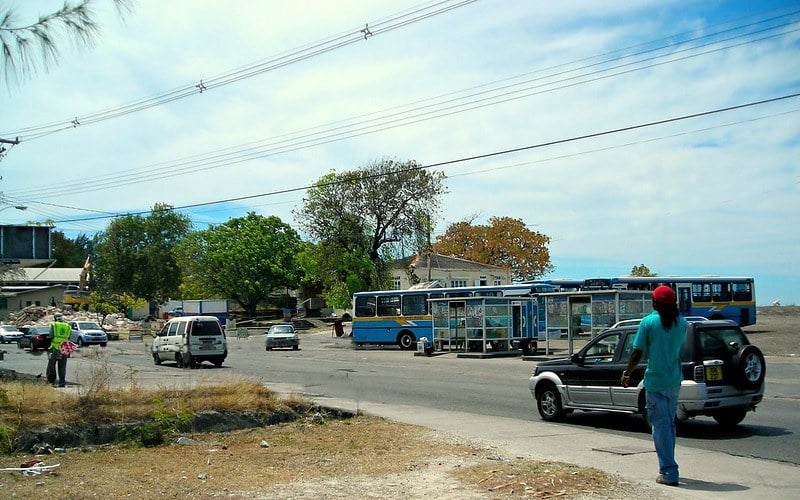
Know that you drive on the left in Barbados (like the British) and also that small-children must have child seats. It’s a given anyway, but you should be wearing a seatbelt.
In general, though driving in Barbados can be done, we recommend that only experienced drivers tackle it. Otherwise hiring a driver, or using taxis, to get around is the way to go.
Is Uber safe in Barbados?
There is no Uber available in Barbados, nor is there any other ride-hailing platform on offer.
Are taxis safe in Barbados?
Taxi service in Barbados is pretty good. There are so many taxis to choose from, they operate 24 hours a day, and – lacking meters – you know you won’t get messed around because the rates are fixed by the government.
The only bad news about taxis in Barbados is the importance of getting in a licensed taxi. Unlicensed taxis do operate and it is not advised, at all, that you hop into one of these.
To ascertain that a taxi is licensed or not, look at the numberplate: this will have “Z” on it. On the roof of the car, there will also be “TAXI” sign.
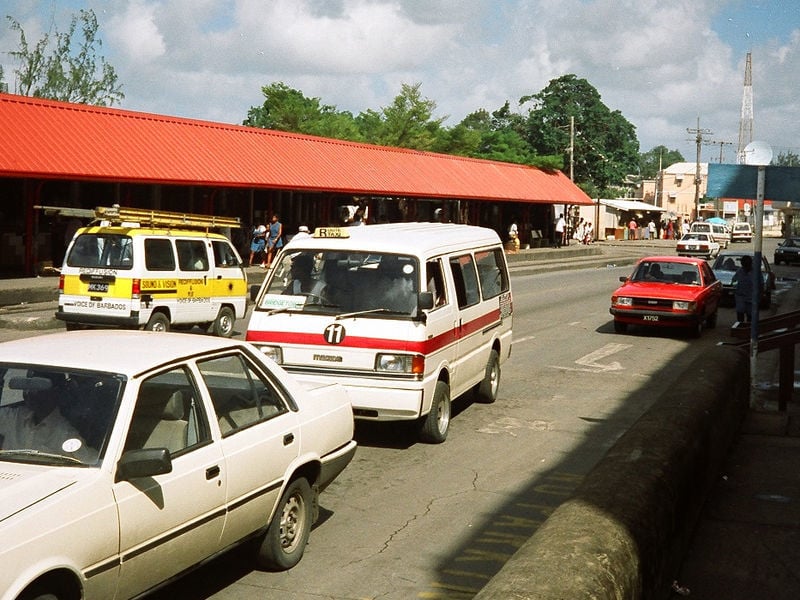
Being a taxi driver is an important income for many of the Bajan (Barbadians) who choose to drive taxis; outside of high tourist season, it can be hard for drivers to get a fair wage, so it’s good to keep this in mind when you’re taking a taxi.
It is also possible to hire a driver per hour or for the day, for a negotiated price.
It is important to understand that there are excess fees (not a scam) when it comes to the taxis in Barbados – excess luggage, for example, being one of them.
Is public transportation in Barbados safe?
The public transport in Barbados is easy to use and fairly safe, though there isn’t that much of it – it consists mainly of buses.
The bus network, however, is far-reaching and you can pretty much get to wherever you need to get to on the island just by riding the bus. It’s efficient and not greatly expensive, either.
First of all, the government-owned public buses are the main way to get around. These are large buses which are blue with a yellow stripe.
These buses can take visitors to popular sites around the island and are very comprehensive. In fact, they even have their own online route-finder to make things easy for visitors.
Another type of bus that you can use while in Barbados are privately owned minibuses. These are yellow with a blue stripe.
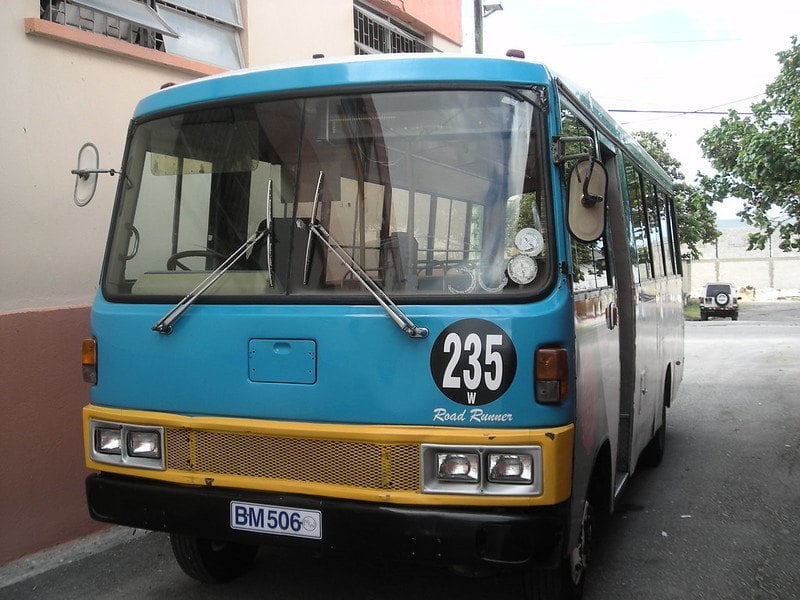
Thirdly, there are route taxis, also known as “ZR vans”, which are white with maroon stripes; they can also be identified by the “ZR” on their number plates.
These are a bit more of an experience than riding the regular public bus; though they run the same routes as the public bus, they can be crowded, break suddenly, and tend to stop a lot. They also blast loud reggae music while travelling at high speed.
Is the food in Barbados safe?
Bajan cuisine is a big mix of many influences: Irish, Indian, British, Portuguese, African, Creole – it’s all there.
There is necessarily a lot of deliciousness to enjoy if you to choose to explore the culinary world of this Caribbean country. To help you explore this island nation’s food like a pro, we are sharing with you our top tips on getting to know the food in Barbados…
- Follow the locals. Your guidebook may be leading you to places that are more convenient than authentic, so go to places that look as though they are local favorites.
- Avoid typical touristy restaurants. Tourist traps like this tend not to have hygiene as their top priority, either.
- Try to avoid things that look as though they have been sitting out in the sun for a while (especially if they are not covered).
- Don’t be afraid of a humble food truck or food shack. As with before, just make sure it is busy with locals.
- Wash your hands; do this before you eat and at least you won’t be the one making yourself ill.
- Note that one of the biggest causes of getting ill in many countries is resort food. Buffets may be very convenient and the easy option, but food that has been sitting around in metal trays for who knows how long is not the most trustworthy of things.
- Bring along some anti-diarrhea medication and rehydration sachets – just in case. Your stomach may not be able to handle the change in diet, the new ingredients and spices used in Bajan cooking.
- There is a lot of fish and seafood on offer in Barbados, which is great, but just make sure that what you’re eating is fresh. If it smells or tastes off, stop eating; food poisoning from seafood is the worst.
The food in Barbados is much loved by the islanders, and you will soon fall in love with it, too. Often made with fresh local produce, with a distinct Bajan flavour, there are a whole lot of interesting dishes to explore when you’re here.

Can you drink the water in Barbados?
Tap water is safe to drink all over Barbados. It follows World Health Organisation regulations, and some claim it is the purest water you can find.
While the jury may be out on the purity, it’s definitely safe to drink. Bring along a refillable water bottle and refill where and when you can instead of buying unnecessary plastic bottles of water and contributing to the plastic problem that we are currently facing.
Is Barbados safe to live?
It is important to know that living in Barbados is very different to visiting Barbados on vacation. You may have work to do, so you won’t necessarily be able to chill out all day, and there will be everyday annoyances, paperwork to fill in, shopping to do, and all the things that can make a place very everyday and mundane.
That said, the relaxed mindset – though charming on vacation – may be a little hard to get used to as a constant in your life. There’s a slow pace, people don’t rush around, and things may take a while to get done.
There are small tight-knit communities on Barbados where everybody seems to know everybody, which could be hard to get used to. It is also very densely populated, and is actually the 18th most densely populated country in the world.
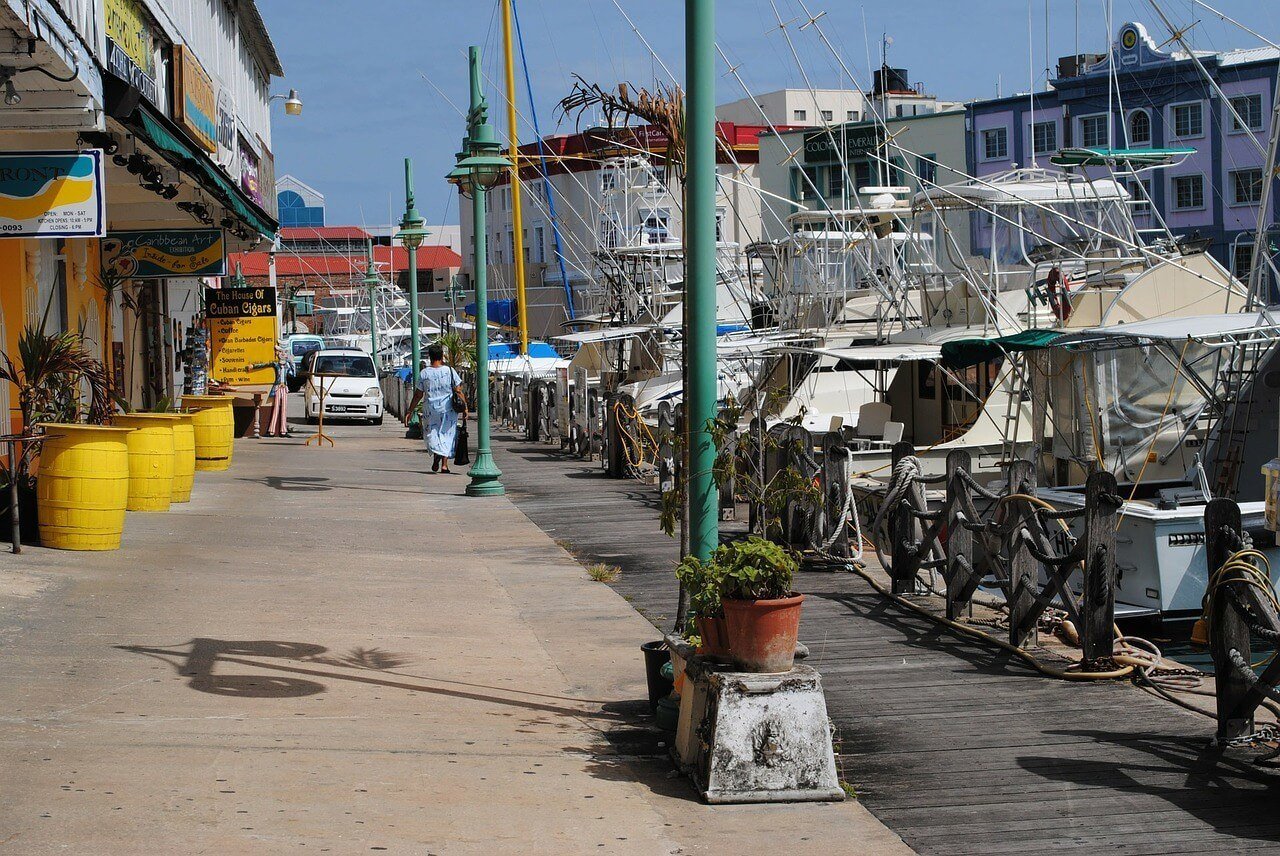
The weather, the warmth and blue skies, maybe great, but there is another side to the coin. There can be heavy rains during the wet season and, from June to November, there is the threat of hurricanes, which can be devastating.
Although the crime rate is low compared to other islands in the area, violent crime is not unheard of. Robbery and burglary can also take place, which is yet another reason to ensure that where you choose to live is safe and secure.
At the end of the day, it is important to do your research. Make sure that you are talking to other people online who have made the move, checking out good places to live and people you can meet up with.

A new country, a new contract, a new piece of plastic – booooring. Instead, buy an eSIM!
An eSIM works just like an app: you buy it, you download it, and BOOM! You’re connected the minute you land. It’s that easy.
Is your phone eSIM ready? Read about how e-Sims work or click below to see one of the top eSIM providers on the market and ditch the plastic .
Is it safe to rent an Airbnb in Barbados?
Renting an Airbnb in Barbados is very safe. In fact, if you don’t want to stay at the all-inclusive resorts, an Airbnb home will be the safest options. Not only are you protected by the booking process of the company, you can also check on reviews and ratings from previous travellers.
You can find Airbnbs all over Barbados, but most homes are located in Bridgetown. You can choose from plenty of awesome private rooms to spacious and stunning beachfront studios all to yourself.
If you’re worried about safety, some vacation rentals in Barbados come in gated communities with a security guard, so you can always look for these types of accommodation when choosing a place to stay.
Planning a safe trip to Barbados can become a bit overwhelming at times. To help you out, we’ve listed and answered the most frequently asked questions on how to stay safe in Barbados.
What should you avoid in Barbados?
Avoid these things in Barbados to add another safety level to your stay: – Don’t visit during hurricane season – Don’t walk around in isolated areas alone – Don’t underestimate how strong the current can be – Don’t dress in camouflage! It’s considered offensive.
What are the safest places in Barbados?
The safest places in Barbados are Rockley and Silver Sands. Rockley offers a bit more action and lovely beaches, while Silver Sands is known for more secluded, peaceful accommodation and windswept shores.
Is Barbados the safest Caribbean island?
No, Barbados is not the safest Caribbean island. That spot is taken by Montserrat, however, Barbados follows shortly after on the list, as it’s definitely one of the safer islands of the Caribbean chain.
Is Barbados LGBTQ+ friendly?
No, Barbados is not LGBTQ+ friendly at all. In fact, homosexual acts are illegal. While it can be safe to visit if you keep your relationship with your partner behind closed doors, you might not have the most pleasant trip.
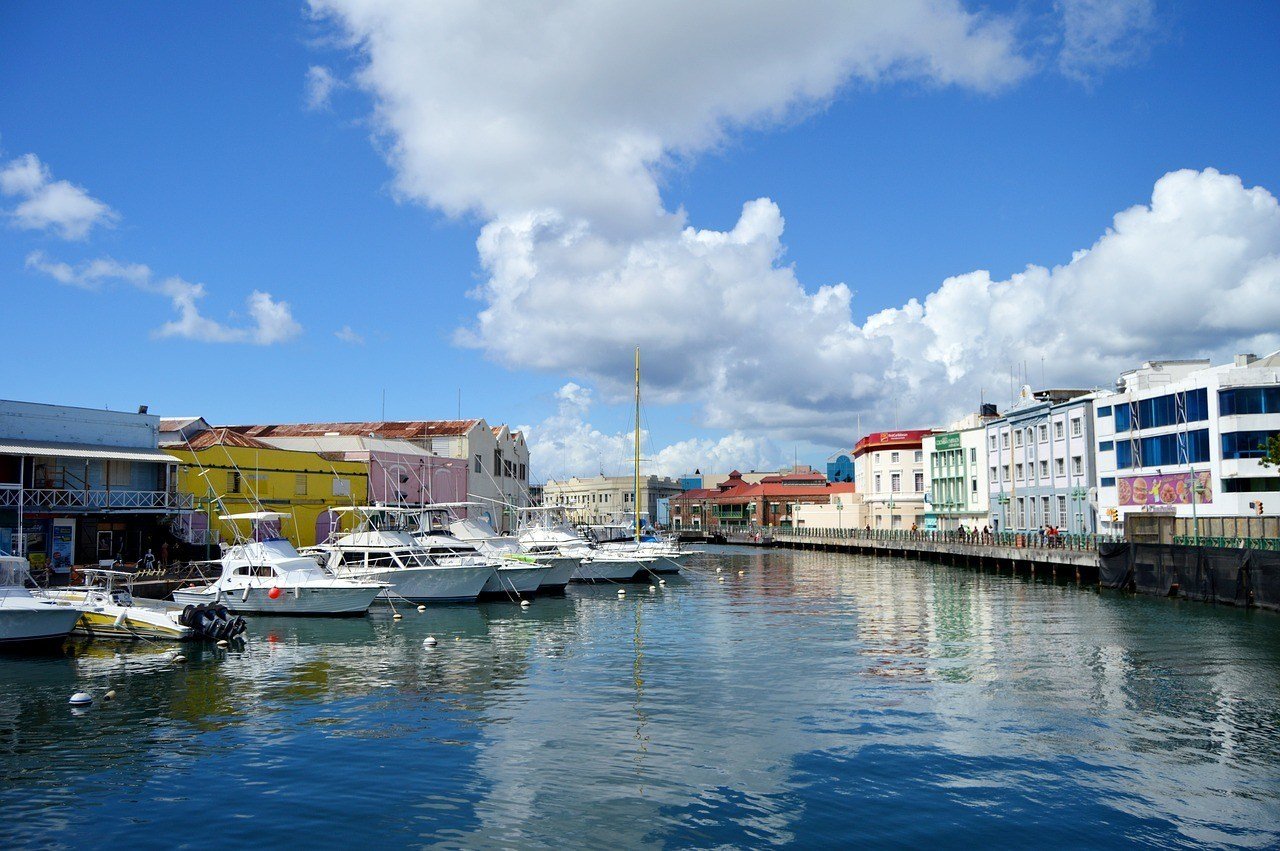
That’s a clear yes from us. Barbados is one of the safest places in the Caribbean . Most visitors to this island nation will be staying in resorts and will be unlikely to see, let alone be affected by, any of the island’s serious crime.
The most important thing is to research the guides and tours you will take, as well as the accommodation you will be staying in, and remember that Barbados is not a theme park. You should still be sensible…
Have you been to Barbados before? Let us know about your travel experience in the comments below.
Disclaimer: Safety conditions change all over the world on a daily basis. We do our best to advise but this info may already be out of date. Do your own research. Enjoy your travels!

And for transparency’s sake, please know that some of the links in our content are affiliate links . That means that if you book your accommodation, buy your gear, or sort your insurance through our link, we earn a small commission (at no extra cost to you). That said, we only link to the gear we trust and never recommend services we don’t believe are up to scratch. Again, thank you!

Lily Allen-Duenas
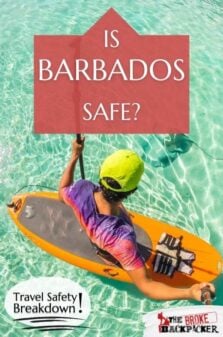
Share or save this post

We stayed in an Air bob in Silver Sands. I can’t stress how important it is to keep your doors locked at all times. There are 2 doors to get into our apartment and we were robbed whilst briefly in another room. My wallet and mobile phone were stolen leaving me in a really bad situation.
I’m just back from a month on Barbados and it was pure paradise. It can be a very expensive island if you jump into the commercial activities.
I travelled solo and camped for the month with Camping Barbados spending most of my stay forest camping, the really wet nights I was offered a room with a host family in the nearby village.
I paid $12.50 a night for a grass pitch and survived on their breakfast options from only $2.50 USD, they even allowed me to run a tab when I struggled withdrawing cash over the bank holiday.
They really did think of everything and the staff went above and beyond to ensure I had a great stay.
I was encouraged to join a hiking group before I arrived and got a list of free hikes I was able to join.
Don’t pass up the chance of trying local foods from the street vendors – fishcakes, rotis, pig tails and grilled fish, of course washed down with a Banks Beer.
It’s not the easiest place to survive on $10 a day but it is doable.
Thank you for the information above on Barbados. I have visited in the past but that was about 15 years ago. I hope to visit after Covid is gone.
Leave a Reply Cancel reply
Your email address will not be published. Required fields are marked *
Save my name, email, and website in this browser for the next time I comment.
Notify me of followup comments via e-mail.

25 Important Disadvantages of Tourism
Disclaimer: Some posts on Tourism Teacher may contain affiliate links. If you appreciate this content, you can show your support by making a purchase through these links or by buying me a coffee . Thank you for your support!
I am sad to say that there are many disadvantages of tourism. Tourism has the power to do so much good, but equally it also has the power to do so much bad. The key is careful and sufficient tourism planning and management. So what are these disadvantages of tourism, why are they so bad and how can we overcome them? Read on to find out…
The 3 categories of disadvantages of tourism
Natural habitat disruption, resource depletion, climate change, wildlife disturbance, coral reefs damage, seasonal nature of tourism, economic dependence, revenue leakage, unequal distribution of income, opportunity cost, over-reliance on a single industry, environmental costs, cost of living, cultural commodification, cultural displacement, commodification of culture, overcrowding, increased crime, social inequality, change in local lifestyles, loss of local employment, inflation in property prices, sustainable tourism practices, involving local communities, education and awareness, diversification of the economy, government regulations and policies, infrastructure development, long-term planning, adaptable management strategies, the disadvantages of tourism- to conclude, the disadvantages of tourism.
As one delves into the captivating world of globetrotting, it is easy to become enamored with the captivating allure of exploration, adventure, and cross-cultural interactions that define the tourist experience. Tourism, undoubtedly, contributes significantly to the economic prosperity of nations, providing employment , generating foreign exchange, and fostering cross-cultural understanding . Yet, there exists a darker side to this glittering façade, one that, more often than not, escapes the radar of mainstream discourse.
This post will highlight the less celebrated aspects of tourism, focusing on its potential downsides that are, somewhat ironically, entwined with its many benefits. Despite the ubiquity of tourism and its significance in today’s globalised world , it is crucial to address its potential for harm in the name of balance and long-term sustainability .
The downsides of tourism are numerous, encompassing aspects such as the environment, culture, economy, and social fabric of tourist destinations . Through this article we will delve into these impacts, seeking to not merely criticise, but also to inspire a rethinking of our attitudes and practices around tourism. By doing so, we endeavour to shed light on how we might navigate these complex issues and foster a more responsible and sustainable approach to tourism .
The disadvantages of tourism can be broken down into three categories: economic, environmental and social. I have summarised these below for you.
Now lets dig a bit deeper into the disadvantages of tourism outlined above one by one…
Environmental Disadvantages of Tourism
If responsible tourism practises are not employed, tourism can, and does, cause significant harm to the environment. I have outlined some of the most common examples of the environmental disadvantages, also known as environmental impacts of tourism , of tourism below for you.

Tourism often leads to deforestation and disruption of natural habitats to accommodate tourists , causing a significant loss of biodiversity. This could involve clearing land for accommodations or other facilities, thereby endangering flora and fauna unique to the area.
How can we mitigate or reduce this disadvantage of tourism?
Sustainable tourism practices, including limiting development in sensitive areas, promoting eco-tourism , and educating tourists about responsible travel , can help preserve natural habitats.
Tourism can strain natural resources, particularly water and food supplies, especially in regions where these resources are already scarce. The increased demand can lead to overexploitation, endangering the long-term availability of these resources.
Implementing resource management strategies, promoting the use of renewable resources, and encouraging tourists to respect local resources can help mitigate this issue.
Tourism contributes to various forms of pollution. Air pollution results from transport, noise pollution from increased activity, litter from irresponsible disposal of waste, and other types of pollution, all of which can degrade local environments and disturb wildlife.
Establishing and enforcing environmental regulations, utilising environmental impact surveys , promoting green travel options, and educating tourists about proper waste disposal can help reduce pollution.
High tourist traffic can cause physical damage to natural landscapes. For example, excessive hiking and foot traffic can lead to soil erosion and degradation of historic sites, damaging these irreplaceable resources.
Restricting access to vulnerable areas, creating designated pathways, and educating tourists about the importance of preserving these sites can help reduce erosion.
The carbon footprint from travel, especially air travel, contributes to greenhouse gas emissions, leading to global climate change. Tourism’s contribution to climate change can have far-reaching consequences for ecosystems worldwide.
Promoting low-carbon transportation options , implementing carbon offset programs, and raising awareness about the environmental impacts of travel can help mitigate tourism’s contribution to climate change.
Human interaction can disturb the natural behaviour of wildlife. Some species may become overly dependent on human food sources, while others may react aggressively or retreat from their natural habitat, disrupting the balance of local ecosystems.
Educating tourists about respectful wildlife interaction, enforcing rules about feeding wildlife, and promoting non-intrusive wildlife viewing experiences can help to reduce disturbance.
Activities like snorkelling and diving can unintentionally damage delicate coral reefs . Additionally, increased boat traffic can lead to oil leaks and other pollution, posing a threat to marine life.
Implementing and enforcing marine protected areas, educating tourists about coral-friendly snorkelling and diving practices, and monitoring boat activity can help protect coral reefs.
Economic Disadvantages of Tourism
Unfortunately, there are many economic disadvantages of tourism, also known as negative economic impacts of tourism . I have outlined the most common below.

Tourism tends to be seasonal, often peaking during particular times of the year. This fluctuation can lead to periods of high employment followed by periods of widespread job loss, creating economic instability. This cyclical pattern can be challenging for local communities that heavily depend on tourism, making budgeting and financial stability a strenuous task.
Diversifying tourism offers, promoting off-peak travel and developing other forms of sustainable local industries can help smooth out the seasonal fluctuations of tourism and provide more stable employment.
The increased demand for goods and services during the tourist season often leads to price inflation . This surge in prices can result in an increased cost of living for local residents, making everyday goods and services more expensive and less accessible.
Implementation of policy measures to control inflation and monitoring of prices, especially of essential goods, during the peak season can help ensure that locals are not negatively impacted.
Regions that rely heavily on tourism can become economically vulnerable in the face of downturns in the industry. These downturns can be triggered by numerous factors such as natural disasters, political instability, global pandemics, or even changing travel trends. This economic fragility poses a significant threat to the livelihoods of local communities.
Diversifying the local economy by promoting and developing other industries can help reduce dependence on tourism and build economic resilience.
Often, a substantial proportion of the revenue generated by tourism does not benefit the local economy but ends up in the hands of foreign-owned businesses , such as international hotel chains and airlines. This phenomenon, known as revenue leakage, can undermine the local economic benefits of tourism.
Encouraging and investing in locally owned businesses and promoting local goods and services can help ensure that more of the tourism revenue stays within the local economy.
The economic benefits of tourism are often unevenly distributed within a community, exacerbating income disparities. More affluent regions or populations tend to gain more from tourism, while less affluent regions or marginalised populations gain less, exacerbating economic inequality.
Implementing policies and practices that promote equitable distribution of tourism revenue can help counter this problem. This might include investing in community-based tourism projects and ensuring fair wages for all tourism-related workers.
Investment in tourism-related infrastructure and services can lead to the neglect of other sectors of the local economy, potentially limiting overall economic development. The resources devoted to tourism could be used elsewhere, potentially offering better long-term economic outcomes.
Balanced investment in various sectors of the economy can help ensure broader economic development, reducing the opportunity costs associated with over-investment in tourism.
Over-dependence on tourism can lead to the neglect of other potential industries, limiting the diversification of the local economy. This lack of diversification can leave the local economy vulnerable to shocks in the tourism industry.
Diversifying the local economy by promoting various industries can help ensure economic stability even when tourism experiences downturns.
Tourism often drives environmental degradation and loss of natural resources, which have their own economic costs. These can include the expense of building infrastructure in sensitive areas, cleaning up pollution , and the lost opportunities for alternative uses of the land .
Implementing sustainable tourism practices that prioritise environmental conservation can help to reduce these costs. This includes regulating tourist activities in sensitive areas and investing in sustainable infrastructure.
Increased tourism can raise property prices and the cost of living, making it challenging for local residents to afford their community. As demand for properties increases with tourist influx, locals may be priced out of their own housing market.
Governments can implement regulations and controls on property prices, especially in regions that are experiencing or are at risk of high tourism-driven property inflation. Policies can also be put in place to ensure affordable housing for local residents is protected and preserved.
The commercialisation of local culture and traditions for the tourist market can lead to “ staged authenticity ,” where cultural activities are modified to cater to tourists. This commodification can potentially lead to the loss of cultural heritage and its inherent economic value, damaging the uniqueness that made the location attractive in the first place.
Policies that protect and promote the preservation of cultural heritage can help counter this effect. Additionally, educating tourists about the importance of preserving local culture and promoting authentic cultural exchanges can lead to more respectful and sustainable tourism practices.
Social Disadvantages of Tourism
There are also many social disadvantages of tourism, also known as social impacts of tourism , that need to be considered. I have outlined the major issues that are commonly encountered below.

The influx of tourists can lead to displacement of local populations and their cultural identities, resulting in a loss of cultural diversity . This phenomenon often results from the pressure to accommodate tourists and can erode the local way of life.
Respecting and protecting local cultures, promoting responsible tourism , and involving local communities in tourism planning can help mitigate cultural displacement.
The commercialisation of local customs and traditions for the tourist market can lead to the loss of cultural authenticity and exploitation of cultural heritage. Traditional practices may be transformed into spectacles for tourists, sometimes leading to staged and insincere representations.
Promoting cultural understanding and respect among tourists, supporting community-owned tourism initiatives, and setting guidelines for respectful cultural engagement can help preserve cultural authenticity .
An influx of tourists can lead to overcrowding, straining local facilities and infrastructure, and reducing the quality of life for local residents. This can create tension between tourists and local communities and degrade the visitor experience.
Implementing visitor management strategies, promoting off-peak travel, and developing infrastructure in a sustainable way can help manage overcrowding.
Some destinations may experience an increase in crime rates associated with tourism, including theft, drug trafficking, and exploitation. This can disrupt the local social fabric and lead to unsafe conditions for both tourists and locals.
Enforcing laws, ensuring adequate security measures, and educating tourists about safe practices can help curb crime associated with tourism.
Tourism can exacerbate social inequalities if the financial benefits of tourism are not evenly distributed within the community. This can lead to social tension and resentment within the local population .
Ensuring fair wages, promoting local ownership of tourism businesses, and implementing policies that promote the equitable distribution of tourism revenue can help address social inequality.
The presence of tourists can influence the behaviour and attitudes of local people, sometimes encouraging undesirable behaviours such as begging or petty crime. This can disrupt local norms and create social issues.
Promoting responsible tourism, involving local communities in decision-making processes, and ensuring that tourism benefits flow to the community can help reduce negative influences on local lifestyles.
In some cases, tourism can lead to the displacement of traditional industries, causing job loss among local populations. This can destabilise local economies and disrupt social structures.
Encouraging sustainable and inclusive tourism development that complements rather than replaces local industries can help preserve local employment.
An influx of tourists can increase demand for real estate, inflating property prices and potentially making it unaffordable for locals to own property in their own community. Companies such as Airbnb can exasperate this issue. This can lead to social displacement and exacerbate economic inequality.
Implementing policy measures to control property price inflation and ensuring affordable housing for locals can mitigate this impact.
How Can Destinations Balance The Disadvantages of Tourism With The Advantages of Tourism?
Balancing the disadvantages of tourism and advantages of tourism is a delicate task requiring thorough planning, strategic management, and conscious efforts from all stakeholders involved, including tourists, the local community, and the government. Below are some strategies that can help:

This approach focuses on minimising the disadvantages of tourism while maximising the advantages of tourism. These practices might include limiting the number of tourists allowed in a certain area at any one time, promoting off-peak travel, and supporting eco-tourism initiatives.
By involving local communities in the planning and decision-making processes, destinations can ensure tourism development aligns with local needs and values. This can also help distribute the economic benefits of tourism more evenly, reducing social inequality.
Raising awareness among tourists about the impacts of their behaviour can lead to more respectful and environmentally friendly behaviours. This can be achieved through informational campaigns, signage, and guidelines, all of which can help to reduce some of the disadvantages of tourism.
By promoting other sectors of the economy alongside tourism, destinations can mitigate the risk of over-dependence on tourism and provide alternative employment options for local communities.
Governments can establish regulations and policies to manage the disadvantages of tourism. This might include zoning laws to protect sensitive environments, regulations to prevent exploitation of cultural heritage, and policies to ensure equitable distribution of tourism revenue.
Thoughtful and sustainable infrastructure development can manage the influx of tourists, mitigate environmental impacts, and enhance the quality of life for local residents.
Taking a long-term perspective in tourism development can help balance immediate economic benefits with the need to preserve a destination’s cultural and natural resources for future generations.
Given the unpredictability of tourism demand , adaptable management strategies can help destinations respond to changes and mitigate negative impacts. This might involve regular monitoring of tourism impacts, feedback mechanisms, and flexibility in policy implementation.
By adopting these strategies, destinations can work towards a more balanced and sustainable tourism model that reaps the benefits of tourism while managing the disadvantages of tourism.
As you can see, there are unfortunately many disadvantages of tourism. However, just because these disadvantages of tourism currently exist, doesn’t mean that have to continue. With adequate planning, policies and governance and with sustainability principles and long-term planning at the forefront of our minds, we can limit the disadvantages of tourism significantly.
If you enjoyed this article about the disadvantages of tourism, I am sure you will enjoy these too:
- Leiper’s Tourism System: A simple explanation
- What is industrial tourism and why is it so popular?
- What is e-tourism and how is it changing travel?
- 150 fascinating types of tourism you didn’t know existed
- 50 fascinating facts about the travel and tourism industry
Liked this article? Click to share!

Contemporary Issues Within Caribbean Economies pp 235–264 Cite as
Caribbean Tourism Development, Sustainability, and Impacts
- David Mc. Arthur Baker 3
- First Online: 09 June 2022
284 Accesses
The Caribbean economy is highly dependent on the tourism industry and the protection of the natural and cultural attractions on which it depends is critical. To address this concern, this chapter provides a snapshot of the progress that has been made on sustainable tourism development in the Caribbean region. There is now more demand from the traveling public for industries to be environmentally friendly and in order to continue to use tourism as a means of economic advancement, sustainable practices must be adopted. The evidence suggests that there are great economic, sociocultural, and environmental impacts of tourism in the Caribbean region that are both positive and negative. The actions of the accommodations sector are commendable but there is the need for all major stakeholders to better manage the negative impacts of tourism development. The Caribbean Tourism Organization has developed a policy framework which consists of guiding principles and integrated policies regarding sustainable tourism development, The Caribbean Sustainable Tourism Policy and Development Framework. A shock, such as COVID-19, can lead to economic collapse as communities heavily dependent on tourism have no capacity to respond to the loss of their primary revenue source. However, in order to strengthen the resilience of small island tourism development, the Caribbean region is transitioning toward community-driven solutions through innovation, employee training, upgrades, greater digitalization, and environmental sustainability.
This is a preview of subscription content, log in via an institution .
Buying options
- Available as PDF
- Read on any device
- Instant download
- Own it forever
- Available as EPUB and PDF
- Compact, lightweight edition
- Dispatched in 3 to 5 business days
- Free shipping worldwide - see info
- Durable hardcover edition
Tax calculation will be finalised at checkout
Purchases are for personal use only
Abdool, A. (2002). Residents’ perceptions of tourism: A comparative study of two Caribbean communities (Doctoral dissertation, Bournemouth University). ProQuest Dissertations and Theses Global. https://core.ac.uk/download/pdf/76947.pdf
Adrian, S. C. (2017). The impact of tourism on the global economic system. Ovidius University Annals, Economic Sciences Series, 17 (1), 384–387.
Google Scholar
Albattat, A. (2017). Current issue in tourism: Diseases transformation as a potential risk for travelers. Global and Stochastic Analysis, 5 (7), 341–350.
Anderson-Fye, E. P. (2004). A “Coca-Cola” shape: Cultural change, body image, and eating disorders in San Andrés, Belize. Culture, Medicine and Psychiatry, 28 (4), 561–595. https://doi.org/10.1007/s11013-004-1068-4
Article Google Scholar
Aref, F., Gill, S. S., & Farshid, A. (2010). Tourism development in local communities: As a community development approach. Journal of American Science, 6 , 155–161.
Bakar, N. A., & Rosbi, S. C. (2020). Effect of Coronavirus disease (COVID-19) to tourism industry. International Journal of Advanced Engineering Research and Science, 7 (4), 189–193. https://doi.org/10.22161/ijaers.74.23
Baker, D. M. A. (2015). Tourism and the health effects of infectious diseases: Are there potential risks for tourists? International Journal Safety and Security of Tourism and Hospitality, 1 (12), 18. https://www.palermo.edu/Archivos_content/2015/economicas/journal-tourism/edicion12/03_Tourism_and_Infectous_Disease.pdf
Baker, D., & Unni, R. (2018). Characteristic and intentions of cruise passengers to return to the Caribbean for land-based vacations. Journal Tourism – Revista de Turism, 26, 1–9.
Baker, D., & Unni, R. (2021). Understanding residents’ opinions and support towards sustainable tourism development in the Caribbean: The case of Saint Kitts and Nevis. Coastal Business Journal, 18 (1), 1–29.
Becken, S. (2014). Water equity-contrasting tourism water use with that of the local community. Water Resources and Industry, 7 (8), 9–22. https://doi.org/10.1016/j.wri.2014.09.002
Becker, A. E. (2004). Television, disordered eating, and young women in Fiji: Negotiating body image and identity during rapid social change. Culture, Medicine and Psychiatry, 28 (4), 533–559. https://doi.org/10.1007/s11013-004-1067-5
Becker, A. E., Fay, K., Agnew-Blais, J., Guarnaccia, P. M., Striegel-Moore, R. H., & Gilman, S. E. (2010). Development of a measure of “acculturation” for ethnic Fijians: Methodologic and conceptual considerations for application to eating disorders research. Transcultural Psychiatry, 47 (5), 754–788. https://doi.org/10.1177/1363461510382153
Behsudi, A. (2020, December). Wish you were here. Finance & Development . https://www.imf.org/external/pubs/ft/fandd/2020/12/pdf/impact-of-the-pandemic-on-tourism-behsudi.pdf
Bellos, V., Ziakopoulos, A., & Yannis, G. (2020). Investigation of the effect of tourism on road crashes. Journal of Transportation Safety & Security, 12 (6), 782–799. https://doi.org/10.1080/19439962.2018.1545715
Bohdanowicz, P., Simanic, B., & Martinac, I. (2004, October 27–29). Sustainable hotels—Eco-certification according to EU Flower, Nordic Swan and the Polish Hotel Association. In Proceedings of the Regional Central and Eastern European Conference on Sustainable Building (SB04) . Warszawa, Poland.
Brewster, R., Sundermann, A., & Boles, C. (2020). Lessons learned for COVID-19 in the cruise ship industry. Toxicology and Industrial Health, 36 (9), 728–735.
Brida, J. G., & Zapata, S. (2010). Cruises tourism: Economic, socio-cultural and environmental impacts. International Journal of Leisure and Tourism Marketing, 1 (3), 205–226.
Britton, S. (1989). Tourism, dependency, and development: A mode of analysis. Europäische Hochschulschriften 10 (Fremdenverkehr), 11, 93–116.
Bushell, R., & McCool, S. F. (2007). Tourism as a tool for conservation and support of protected areas: Setting the agenda. In R. Bushell & P. F. J. Eagles (Eds.), Tourism and protected areas: Benefits beyond boundaries (pp. 12–26). CABI International.
Butt, N. (2007). The impact of cruise ship generated waste on home ports and ports of call: A case study of Southampton. Marine Policy, 31 (5), 591–598.
Cannonier, C., & Burke, M. G. (2019). The economic growth impact of tourism in small island developing states-evidence from the Caribbean. Tourism Economics, 25 (1), 85–108.
Caribbean Hotel Association. (2014). Advancing sustainable tourism, a regional sustainable tourism situation analysis: Caribbean . https://caribbeanhotelandtourism.com/
Castillo-Manzano, J. I., Castro-Nuño, M., López-Valpuesta, L., & Vassallo, F. V. (2020). An assessment of road traffic accidents in Spain: The role of tourism. Current Issues in Tourism, 23 (6), 654–658. https://doi.org/10.1080/13683500.2018.1548581
Castro, C. (2004). Sustainable development: Mainstream and critical perspective. Organization and Environment, 17 (2), 195–225.
Chang, C., McAleer, M., & Ramos, V. (2020). A charter for sustainable tourism after COVID-19. Sustainability, 12 (9), 3671. https://doi.org/10.3390/su12093671
Chappell, K., & Frank, M. (2020). The most tourism-dependent region in the world braces for prolonged Coronavirus recovery . Reuters. https://skift.com/2020/04/20/the-most-tourism-dependent-region-in-the-world-braces-for-prolonged-coronavirus-recovery/
Charles, D. (2013). Sustainable tourism in the Caribbean: The role of the accommodations sector. International Journal of Green Economics, 7 (2), 148–161.
Cheng, T. L., & Conca-Cheng, A. M. (2020). The pandemics of racism and COVID-19: Danger and opportunity. Pediatrics, 146 (5), e2020024836. https://doi.org/10.1542/peds.2020-024836
Choi, H. C., & Sirakaya, E. (2006). Sustainability indicators for managing community tourism. Tourism Management, 27 (6), 1274–1289.
Cole, S. (2014). Tourism and water: From stakeholders to rights holders, and what tourism businesses need to do. Journal of Sustainable Tourism, 22 (1), 89–106. https://doi.org/10.1080/09669582.2013.776062
Cook, C. L., Li, Y. J., Newell, S. M., Cottrell, C. A., & Neel, R. (2018). The world is a scary place: Individual differences in belief in a dangerous world predict specific intergroup prejudices. Group Processes & Intergroup Relations, 21 (4), 584–596. https://doi.org/10.1177/1368430216670024
Croes, R., & Vanegas, M., Sr. (2008). Cointegration and causality between tourism and poverty reduction. Journal of Travel Research, 47 (1), 94–103.
Dangi, T. B., & Jamal, T. (2016). An integrated approach to “sustainable community-based tourism.” Sustainability, 8 , 475–507. https://doi.org/10.3390/su8050475
Darma, I. G. K. I. P., Dewi, M. I. K., & Kristina, N. M. R. (2020). Community movement of waste use to keep the image of tourism industry in GIANYAR. Journal of Indonesian Tourism, Hospitality and Recreation, 3 (1), 49–57. https://doi.org/10.17509/jithor.v3i1.23439
Deloitte. (2012). Sustainability for consumer business operations: A story of growth . https://www2.deloitte.com/content/dam/Deloitte/global/Documents/Consumer-Business/dttl_cb_Sustainability_Global%20CB%20POV.pdf
Farmer, P. (2006). AIDS and accusation: Haiti and the geography of blame . University of California Press.
Findlater, A., & Bogoch, I. I. (2018). Human mobility and the global spread of infectious diseases: A focus on air travel. Trends in Parasitology, 34 (9), 772–783. https://doi.org/10.1016/j.pt.2018.07.004
Ghadban, S., Shames, M., & Abou Mayaleh, H. (2017). Trash crisis and solid waste management in Lebanon-analyzing hotels’ commitment and guests’ preferences. Journal of Tourism Research & Hospitality, 6 (3), 1000169. https://doi.org/10.4172/2324-8807.1000171
Gössling, S., Peeters, P., Hall, C. M., Ceron, J.-P., Dubois, G., Lehmann, L. V., & Scott, D. (2012). Tourism and water use: Supply, demand, and security. An international review. Tourism Management, 33 (1), 1–15. https://doi.org/10.1016/j.tourman.2011.03.015
Greening, A. (2014). Understanding local perceptions and the role of historical context in ecotourism development: A case study of Saint Kitts (Master’s Thesis, Utah State University). ProQuest Dissertations and Theses Global.
Hanafiah, M. H., Harun, M. F., & Jamaluddin, M. R. (2010). Bilateral trade and tourism demand. World Applied Sciences Journal, 10 , 110–114.
Harry-Hernández, S., Park, S. H., Mayer, K. H., Kreski, N., Goedel, W. C., Hambrick, H. R., Brooks, B., Guilamo-Ramos, V., & Duncan, D. T. (2019). Sex tourism, condomless anal intercourse, and HIV risk among men who have sex with men. Journal of the Association of Nurses in AIDS Care, 30 (4), 405–414. https://doi.org/10.1097/JNC.0000000000000018
Haukeland, J. V. (2011). Tourism stakeholders’ perceptions of national park management in Norway. Journal of Sustainable Tourism, 19 (2), 133–153.
Haywood, M. K. (2020). A post COVID-19 future—Tourism re-imagined and re-enabled. Tourism Geographies, 22 (3), 599–609. https://doi.org/10.1080/14616688.2020.1762120
Homans, C. G. (1958). Social behavior as exchange. American Journal of Sociology, 63 (6), 597–606.
Hoppe, T. (2018). “Spanish Flu”: When infectious disease names blur origins and stigmatize those infected. American Journal of Public Health, 108 (11), 1462–1464. https://doi.org/10.2105/AJPH.2018.304645
Hung, C. H., & Wu, M. T. (2017). The influence of tourism dependency on tourism impact and development support attitude. Asian Journal of Business and Management, 5, 88–96. https://doi.org/10.24203/ajbm.v5i2.4594
International Ecotourism Society. (2004). The triple bottom line of sustainable tourism . https://www.coursehero.com/file/81910666/s1pdf/
Jamal, T., & Stronza, A. (2009). Collaboration theory and tourism practice in protected areas: Stakeholders, structuring and sustainability. Journal of Sustainable Tourism, 17 (2), 169–189.
Johnson, D. (2002). Environmentally sustainable cruise tourism: A reality check. Marine Policy, 26 (4), 261–270.
Jones, P., Hillier, D., & Comfort, D. (2016). The environmental, social and economic impacts of cruising and corporate sustainability strategies. Athens Journal of Tourism, 3 (4), 273–285.
Jordan, E. J. (2014). Host community resident stress and coping with tourism development (Doctoral dissertation, Michigan State University, East Lansing, MI). ProQuest Dissertations and Theses Global.
Jordan, E. J., Lesar, L., & Spenser, D. M. (2021). Clarifying the interrelations of residents’ perceived tourism-related stress, stressors, and impacts. Journal of Travel Research, 60 (1), 208–219. https://doi.org/10.1177/0047287519888287
Jordan, E. J., & Vogt, C. A. (2017). Appraisal and coping responses to tourism development-related stress. Tourism Analysis, 22 (1), 1–18. https://doi.org/10.3727/108354217X14828625279573
Kaseva, M. E., & Moirana, J. L. (2010). Problems of solid waste management on Mount Kilimanjaro: A challenge to tourism. Waste Management & Research, 28 (8), 695–704. https://doi.org/10.1177/0734242X09337655
Klein, R. A. (2011). Responsible cruise tourism: Issues of cruise tourism and sustainability. Journal of Hospitality and Tourism Management, 18 (1), 107–118.
Korstanje, M., & George, B. (2020). Demarketing overtourism, the role of educational interventions. In H. Séraphin & A. C. Yallop (Eds.), Overtourism and tourism education (pp. 81–95). Routledge.
Chapter Google Scholar
Laville-Wilson, D. P. (2017). The transformation of an agriculture-based economy to a tourism-based economy: Citizens’ perceived impacts of sustainable tourism development (Doctoral dissertation, South Dakota State University). South Dakota State University Open Prairie. https://openprairie.sdstate.edu/etd/2262/
Li, Y., & Galea, S. (2020). Racism and the COVID-19 epidemic: Recommendations for health care workers. American Journal of Public Health, 110 (7), 956–957. https://doi.org/10.2105/AJPH.2020.305698
Lubin, D. A., & Esty, D. C. (2010). The sustainability imperative. Harvard Business Review, 88 (5), 42–50.
Lyneham, S., & Facchini, L. (2019). Benevolent harm: Orphanages, voluntourism and child sexual exploitation in South-East Asia. Trends & Issues in Crime and Criminal Justice, 574 . Australian Institute of Criminology. https://www.aic.gov.au/sites/default/files/2020-05/benevolent_harm_orphanages_voluntourism_and_child_sexual_exploitation_in_south-east_asia.pdf
Mackenzie, S., & Goodnow, J. (2020). Adventure in the age of COVID-19: Embracing micro-adventures and locavism in a post-pandemic world. Leisure Sciences, 43 (10), 1–8. https://doi.org/10.1080/01490400.2020.1773984
MacNeill, T., & Wozniak, D. (2018). The economic, social, and environmental impacts of cruise tourism. Tourism Management, 66 , 387–404.
Mansfield, B. (2009). Sustainability. In N. Castree, D. Demeriff, D. Liverman, & B. Rhoads (Eds.), A companion to environmental geography (pp. 37–49). Wiley. https://doi.org/10.1002/9781444305722.ch3
Mansfeld, Y., & Pizam, A. (2006). Tourism, security and safety . Routledge.
Book Google Scholar
Manzoor, F., Wei, L., Asif, M., Zia ul Haq, M., & Rehman, H. (2019). The contribution of sustainable tourism to economic growth and employment in Pakistan. International Journal of Environmental Research & Public Health, 16 (19), 37–85. https://doi.org/10.3390/ijerph16193785
Mawby, R. I. (2017). Crime and tourism: What the available statistics do or do not tell us. International Journal of Tourism Policy, 7 (2), 81–92. https://doi.org/10.1504/IJTP.2017.085292
Miller-Perrin, C., & Wurtele, S. K. (2017). Sex trafficking and the commercial sexual exploitation of children. Women & Therapy, 40 (1–2), 123–151. https://doi.org/10.1080/02703149.2016.1210963
Minooee, A., & Rickman, L. (1999). Infectious diseases on cruise ships. Clinical Infectious Diseases, 29 (4), 737–743.
Murphy, P., & Murphy, A. E. (2004). Strategic management for tourism communities. Channel View Publications.
Nofriya, N. (2018, August 7). Health and safety issues from tourism activities in Bukit Tinggi City, West Sumatra . 13th IEA SEA Meeting and ICPH—SDev. http://conference.fkm.unand.ac.id/index.php/ieasea13/IEA/paper/view/622
Ohlan R., (2017). The relationship between tourism, financial development and economic growth in India. Future Business Journal, 3 (1), 9–22.
Okazaki, E. (2008). A community-based tourism model: Its conception and use. Journal of Sustainable Tourism, 16 (5), 511–529. https://doi.org/10.1080/09669580802159594
Osland, G. E., Mackoy, R., & McCormick, M. (2017). Perceptions of personal risk in tourists’ destination choices: Nature tours in Mexico. European Journal of Tourism, Hospitality and Recreation, 8 (1), 38–50. https://doi.org/10.1515/ejthr-2017-0002
Person, B., Sy, F., Holton, K., Govert, B., Liang, A., Garza, B., Gould, D., Hickson, M., McDonald, M., Meijer, C., Smith, J., Veto, L., Williams, W., & Zauderer, L. (2004). Fear and stigma: The epidemic within the SARS outbreak. Emerging Infectious Diseases Journal CDC, 10 (2), 358–363. https://doi.org/10.3201/eid1002.030750
Peterson, R. R., Harrill, R., & Dipietro, R. B. (2017). Sustainability and resilience in Caribbean tourism economies: A critical inquiry. Tourism Analysis, 22 (3), 407–419. https://doi.org/10.3727/108354217X14955605216131
Petkova, A. T., Koteski, C., Jakovlev, Z., & Mitreva, E. (2012). Sustainability and competitiveness of tourism. Procedia - Social and Behavioral Sciences, 44 , 221–227. https://doi.org/10.1016/j.sbspro.2012.05.023
Qiu, R., Park, J., Li, S., & Song, H. (2020). Social costs of tourism during the COVID-19 pandemic. Annals of Tourism Research, 84, 102994. https://doi.org/10.1016/j.annals.2020.102994
Quevedo-Gómez, M. C., Krumeich, A., Abadía-Barrero, C. E., & Van den Borne, H. W. (2020). Social inequalities, sexual tourism and HIV in Cartagena, Colombia: An ethnographic study. BMC Public Health, 20 (1208), 1–11. https://doi.org/10.1186/s12889-020-09179-2
Ram, Y. (2021). Me too and tourism: A systematic review. Current Issues in Tourism, 24 (3), 321–339. https://doi.org/10.1080/13683500.2019.1664423
Ramesh, D. (2002). The economic contribution of tourism in Mauritius. Annals of Tourism Research, 29 (3), 862–865.
Richter, L. K. (2003). International tourism and its global public health consequences. Journal of Travel Research, 41 (4), 340–347. https://doi.org/10.1177/0047287503041004002
Rittichainuwat, B. N., & Chakraborty, G. (2009). Perceived travel risks regarding terrorism and disease: The case of Thailand. Tourism Management, 30 (3), 410–418. https://doi.org/10.1016/j.tourman.2008.08.001
Robinson, M. (1999). Collaboration and cultural consent: Refocusing sustainable tourism. Journal of Sustainable Tourism, 7 (3–4), 379–397. https://doi.org/10.1080/09669589908667345
Rosselló, J., Santana-Gallego, M., & Awan, W. (2017). Infectious disease risk and international tourism demand. Health Policy and Planning, 32 (4), 538–548. https://doi.org/10.1093/heapol/czw177
Ryan, C., & Kinder, R. (1996). Sex, tourism and sex tourism: Fulfilling similar needs? Tourism Management, 17 (7), 507–518. https://doi.org/10.1016/S0261-5177(96)00068-4
Schwartz, K. L., & Morris, S. K. (2018). Travel and the spread of drug-resistant bacteria. Current Infectious Disease Reports, 20 (9), Article 29. https://doi.org/10.1007/s11908-018-0634-9
Sheller, M. (2004). Natural hedonism: The invention of Caribbean islands as tropical playgrounds. In S. Courtman (Ed.), Beyond the blood, the beach, and the banana : New perspectives in Caribbean studies (pp. 170–185). Ian Randle.
Sönmez, S., Wiitala, J., & Apostolopoulos, Y. (2019). How complex travel, tourism, and transportation networks influence infectious disease movement in a borderless world. In D. J. Timothy (Ed.), Handbook of globalization and tourism (pp. 76–88). Edward Elgar Publishing. https://doi.org/10.4337/9781786431295.00015
Sustainability Accounting Standards Board. (2014). Cruise lines: Sustainability accounting standards . http://www.sasb.org/wp-content/uploads/2014/12/SV0205_Cruise_ProvisionalStandard.pdf
Telfer, D. (2002). The evolution of tourism and development theory. In R. Sharpley & D. Telfer (Eds.), Tourism and development: Concepts and issues (pp. 35–78). Channel View.
The Caribbean Tourism Organization [CTO]. (2020). Caribbean sustainable tourism policy and development framework . https://caricom.org/documents/10910-cbbnsustainabletourismpolicyframework.pdf
Tolkach, D., & King, B. (2015). Strengthening community-based tourism in a new resource-based island nation: Why and how? Tourism Management, 48 , 386–398. https://doi.org/10.1016/j.tourman.2014.12.013
Tosun, C. (2006). Expected nature of community participation in tourism development. Tourism Management, 27 , 493–504.
UNCTAD. (2020). Coronavirus will cost global tourism at least $1.2 trillion . United Nations Conference on Trade and Development. Retrieved January 6, 2021, from https://unctad.org/news/coronavirus-will-cost-global-tourism-least-12-trillion
UNWTO. (2001). Tourism highlights 2001. World Tourism Organization. Madrid. https://doi.org/10.18111/9789284406845
UNWTO. (2019). United Nations World Tourism Report 2019 . Available at: https://www.eunwto.org/doi/pdf/10.18111/9789284421152 . Accessed 24 August 2020.
Walker, L., & Page, S. J. (2004). The contribution of tourists and visitors to road traffic accidents: A preliminary analysis of trends and issues for central Scotland. Current Issues in Tourism, 7 (3), 217–241. https://doi.org/10.1080/13683500408667980
Wallen, B. (2020, November 30). Why some countries are opening back up to tourism during a pandemic. National Geographic . https://www.nationalgeographic.com/travel/article/are-economics-driving-countries-to-reopen-to-tourists-coronavirus
Waterman, T. (2009). Assessing public attitudes and behavior toward tourism development in Barbados: Socio-economic and environmental implications . Central Bank of Barbados.
Wilks, J., Stephen, J., & Moore, F. (2013). Managing tourist health and safety in the new millennium . Routledge.
World Conservation Union. (1996, October 13–23). Resolutions and recommendations [Meeting]. World Conservation Congress, Montreal, Canada. https://portals.iucn.org/library/sites/library/files/documents/WCC-1st-002.pdf
World Travel & Tourism Council (WTTC). (2019). Economic impact reports . https://wttc.org/Research/Economic-Impact
World Travel & Tourism Council (WTTC). (2020). 100 million jobs recovery plan: Final Proposal (G20 2020 Saudi Arabia Summit). https://wttc.org/Portals/0/Documents/Reports/2020/100%20Million%20Jobs%20Recovery%20Plan.pdf?ver=2021-02-25-183014-057
Zheng, D., Luo, Q., & Ritchie, B. (2021). Afraid to travel after COVID-19? Self-protection, coping and resilience against pandemic ‘travel fear.’ Tourism Management, 83, 104261. https://doi.org/10.1016/j.tourman.2020.104261
Download references
Author information
Authors and affiliations.
Hospitality & Tourism Management, College of Business, Tennessee State University, Nashville, TN, USA
David Mc. Arthur Baker
You can also search for this author in PubMed Google Scholar
Corresponding author
Correspondence to David Mc. Arthur Baker .
Editor information
Editors and affiliations.
Jack C. Massey College of Business, Belmont University, Nashville, TN, USA
Colin Cannonier
Western Kentucky University, Bowling Green, KY, USA
Monica Galloway Burke
Rights and permissions
Reprints and permissions
Copyright information
© 2022 The Author(s), under exclusive license to Springer Nature Switzerland AG
About this chapter
Cite this chapter.
Baker, D.M.A. (2022). Caribbean Tourism Development, Sustainability, and Impacts. In: Cannonier, C., Galloway Burke, M. (eds) Contemporary Issues Within Caribbean Economies. Palgrave Macmillan, Cham. https://doi.org/10.1007/978-3-030-98865-4_10
Download citation
DOI : https://doi.org/10.1007/978-3-030-98865-4_10
Published : 09 June 2022
Publisher Name : Palgrave Macmillan, Cham
Print ISBN : 978-3-030-98864-7
Online ISBN : 978-3-030-98865-4
eBook Packages : Economics and Finance Economics and Finance (R0)
Share this chapter
Anyone you share the following link with will be able to read this content:
Sorry, a shareable link is not currently available for this article.
Provided by the Springer Nature SharedIt content-sharing initiative
- Publish with us
Policies and ethics
- Find a journal
- Track your research

- Your Products
- Special Offers
Tourism in Barbados
No matter what time of year, Barbados is without a doubt a tourist hot spot that caters to all travelling tastes and budgets. In fact, the tourism industry has now become the backbone of the Barbadian economy, and the island goes all out to make sure its visitors feel welcome and enjoy their vacation.
There are several key elements that keep tourists coming to the island year after year – its deep events calendar which is regularly updated with all the island’s events and activities.
Author: Brett Callaghan
- Caribbean Tourism Organization CTO
Other Related Articles:
- Barbados Vacations
- Cruise Ships
- Tourism Statistics
About Totally Barbados ( Edit profile )
Things to do in barbados.
- Add an Event
- Entertainment
- South Coast Nightlife
- Weekly Nightlife Guide
- West Coast Nightlife
Pros and Cons of Tourism
Be it Niagara Falls, The Grand Canyon, or the Amazon Rainforest, these places have numerous reasons to attract tourists every year. Tourists love to visit such spots looking for fun, amusement, and even finding peace of mind. Tourism has turned into a thriving industry in many countries. Governments and local communities reap the benefits of tourism in many different ways. But those advantages come with certain risks as well. However, like everything else, there are pros and cons of tourism . You should be taking a closer look at the good and the bad of tourism before you set a vacation schedule alone or with your friends and families.
What are the Pros of Tourism?
In 2021, tourism to Grand Canyon National Park made a significant contribution of $710 million to the local economy, reports National Park Service.
1. Economic Boost
Tourism is a significant contributor to the economy of a country. By attracting tourists, nations can create sustainable revenue streams, generate job opportunities, and boost growth across several sectors. According to a report by NPS, the park welcomed approximately 4.5 million visitors to the Grand Canyon, spending an estimated $710 million in the surrounding gateway regions.
2. Cultural Exchange
Travel can bring people together and provide a unique opportunity to share ideas and experiences. Travelers often have an open mind about different cultures and customs, so they are eager to explore new places. This type of exchange can break down cultural barriers between countries by allowing each party to understand the other's culture better. This exchange of cultural values can be counted as one of the major advantages of tourism.
3. Environmental Conservation
All natural heritages are tourist spots, and people come to admire the view. One of the significant advantages of tourism is that it can help protect and preserve the environment. Local governments can invest the revenue generated by tourism for the betterment of environmentally sensitive regions and areas with fragile ecosystems.
4. Improved Infrastructure is Among the Pros of Tourism
With the influx of tourists, countries can consider upgrading their infrastructure to accommodate visitors' needs. This includes constructing new airports, roads, accommodations, and public facilities such as parks and museums. This positive change can be felt both by the tourists and the inhabitants.
5. Global Recognition
Tourism is an essential part of many countries economies, and it can also provide significant global recognition for the destination. A well-designed tourism strategy that attracts a high volume of international visitors can bring in foreign money, create jobs, and help to develop infrastructure. It also raises awareness about an area, leading to increased interest from the rest of the world.
What are the Cons of Tourism?
Besides the positive changes, tourism also has its share of downsides. Most of the cons of the tourism industry are associated with the misuse of natural resources. Some of the other problems with tourism include:
1. Environmental Damage
Tourism can lead to environmental damage in many ways. For example, it can impact water resources through increased water and wastewater production demand. It can also add to pollution by generating emissions from transportation as visitors travel around the area. Additionally, tourists may increase pressure on local land resources, leading to deforestation and loss of habitats for native species.
2. Displaced Communities
Tourism often brings economic benefits to local communities. Still, when done in a way that does not consider the local community's needs and aspirations, it can cause displacement. Communities may be displaced from their traditional lands or homes, pushing them away from the resources they need for subsistence. This can be particularly detrimental if these resources are already scarce or difficult to access.
3. Cultural Erosion
Cultural Erosion is one of the most dreaded cons of tourism. A tourist destination with a distinct local culture is prone to changes due to the influx of tourists. The more tourism activities are higher the chances of community displacement.
This phenomenon is often compounded by the fact that many tourists come from cultures very different to those of the local community, and their presence can lead to a sudden change in cultural values. This rapid transition can significantly damage a community as its members may no longer feel represented or respected.
4. Economic Dependence
The COVID-19 pandemic best explains how tourism can suddenly burden an economy. As the pandemic wiped out all income for many countries' businesses, many had to rely heavily on government support and bailouts as their primary sources of revenue. This has resulted in rising debts due to emergency aid distributions and other fiscal measures associated with relief during this crisis.
5. Overcrowding
Visiting a particular area can harm the environment and local culture as tourism grows. One of the main disadvantages of tourism is overcrowding, which can strain resources, increase pollution, and damage natural habitats.
Overcrowding can decrease the quality of life for residents, as tourists take up public space and resources. It can also affect the health and safety of visitors who may be exposed to increased levels of crime or air pollution.
Conclusion on the Pros and Cons of Tourism
The pros and cons of tourism are complex if you evaluate them thoroughly. It is easy to see that people benefit from increased access to new cultures, experiences, and destinations.
On the other hand, there are real risks associated with tourist activities like over-tourism and the destruction of natural spaces. Therefore, it's up to individuals to assess these impacts on their own terms. It's up to every citizen to become responsible travelers who understand tourism's positive and negative effects.
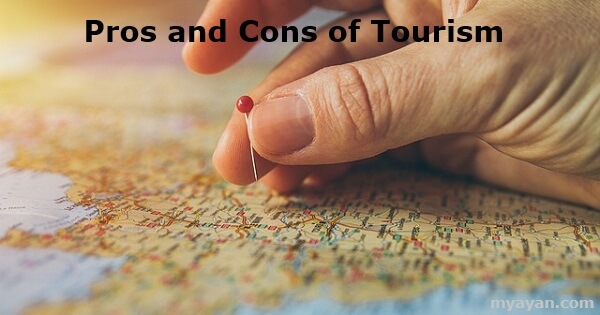
Frequently Asked Questions
What are the cons of tourism.
Tourism frequently exerts excessive strain on natural resources due to overconsumption, particularly in areas with limited resources. It places immense pressure on local land utilization, resulting in soil erosion, heightened pollution levels, loss of natural habitats, and increased jeopardy for endangered species.
What are the pros of tourism?
It fosters job creation, bolsters the local economy, facilitates infrastructure development, preserves the natural environment and cultural heritage, and works towards alleviating poverty and inequality.
What are the social benefits of tourism?
Tourism brings forth numerous social benefits, showcasing its positive impacts on society. These encompass the preservation of local culture and heritage, the fostering of vibrant communities, the provision of essential social services, the promotion of cultural and artistic commerce, the revitalization of customs and art forms, as well as the safeguarding of our precious heritage.
Who does tourism help?
Tourists contribute to the local economy by spending their money, leading to job creation and economic growth. This support is particularly crucial for small businesses, which often struggle to generate substantial profits.
What's your reaction?
Quick links.
- » Home
- » About us
- » Contact us
- » Post Article
- » Privacy policy
- » Terms and Conditions
- » Health and Wellness
- » Education and Communication
- » Computers and Electronics
- » Personal Care and Style
- » Travel Updates and Tourism Guide
- » Finance and Business Sector
- » Food and Entertainment
- » Home and Garden
- » Automobiles Sector

Responsible Green Travel to Barbados
Sustainable eco-tourism in barbados.
The Barbados National Trust engages in the preservation of places of historic, architectural and archaeological interest and of ecological importance or natural beauty. The scope of the Trust includes a number of the island’s cemeteries, gardens, historic houses, nature reserves, park areas, windmills and coastal areas. Managed properties include:

- Welchman Hall Gully – A unique sunken cave system with a large variety of exotic tropical plants and trees. The gully is also home to a large troop of wild green monkeys. For a more detailed and colourful review, check out our Welchman Hall Gully blog post. Located near the centre of the island.
- Andromeda Botanic Gardens – A manicured seaside garden featuring a variety of plants from around the world. Centrally located near Bathsheba on the east coast.
- Morgan Lewis Sugar Mill – This site features the largest and only intact 18th-century windmill in the Caribbean! Located at the northeast end of the island.
- Gun Hill Signal Station – The site of a 19th-century outpost provides one of the most spectacular panoramic views of the island and surrounding southern seas. Located in the south-central part of Barbados.

The Trust, in conjunction with the Barbados National Hiking Association, organizes the following regular hiking activities :

- Stop ‘n’ Stare (easy) typically covering 6 miles (10km)
- Medium typically covering 8 miles (13km)
- Brisk Medium typically covering 10 miles (16km)
- Grin ‘n’ Bear (challenging) typically covering 12 miles (19km)
- Afternoon Hike (3:30pm start / medium paced – 3 hour)
- Moonlight Hike (medium paced – 3 hour)
The Trust also organizes a ‘ Gun Hill by Moonlight ‘ event for a cool relaxing evening reception with refreshments to watch the sunset and view the brilliant moonlit sky.
Barbados also has a number of Parks, Forests, Reserves and Marine Parks to enjoy:

- The Flower Forest Garden – This 53 acre Nature Reserve in the Scotland District displays rare and exotic tropical blooms and foliage along with panoramic views of the island’s ruggedly beautiful east coast. Located near the centre of Barbados.
- Coco Hill Forest – A lush and hilly 53-acre rainforest and farm filled with tropical flora and scenic look-outs of the east coast. Easy “Green Therapy” hiking trails can be enjoyed on your own or as part of a guided tour. Located near the centre of the island.
- PEG Farm and Nature Reserve – Enjoy breathtaking views from Hackleton’s cliff. The farm is all about P eople, E nvironment and G rowth, where they offer an Eco Tour that highlights agricultural and natural sites on the property. Located near the centre of Barbados close to the east coast.
- Farley Hill – This small Barbados National Park is home to the ruins of an impressive 19th-century mansion on a hillside that provides stunning views of the hilly Scottish District and gorgeous east coastline. Located inland at the northern end of Barbados.
- Turner Hall Woods – This 50 acre Nature Reserve is probably the wildest area left in Barbados. This heavily wooded reserve contains diverse flora and fauna, including wild monkeys as well as hiking trails . Located in the north-central part of the island.
- Chancery Lane Swamp – This protected seasonal wetlands area is home to Pelicans, Heron and Frigate Birds. Dozens of migratory shorebirds can also be spotted there. Located at the southern tip of the island.
- Woodbourne Shorebird Refuge – A good location to spot more than a dozen species of shorebirds and waterbirds. Located at the southern end of Barbados.
- Folkestone Marine Park – Located on the west coast of Barbados, a series of large flat reefs are situated within protected buoys. Tropical fish and vibrant marine life can be accessed easily from shore. The Park also includes an Information Centre and Museum.
- Carlisle Bay Marine Park – The waters just offshore from one of the Caribbean’s most famous beaches is home to half a dozen shipwrecks, and other boat remnants, in water as shallow as 12 feet (4m). There’s also plenty of tropical fish and other marine life, including large numbers of turtles and several rays skimming the seafloor.
The vision of the Barbados Sea Turtle Project (BSTP), part of the University of the West Indies, is to restore local marine turtle populations to levels at which they can fulfill their ecological roles while still providing opportunities for sustainable use by the people of Barbados. The BSTP is involved in the conservation of the endangered marine turtle through research, education and public outreach as well as monitoring of nesting females, juveniles and hatchlings. They operate mobile patrol groups and a 24 hr “Sea Turtle Hotline” to monitor sea turtle sightings and address sea turtle “emergencies”.
The Barbados Marine Trust (BMT) was formed in 2000 and is dedicated to promoting environmentally and socially sustainable use of the Marine areas of Barbados. The BMT wishes to play a major role in assisting the Government of Barbados in the implementation of marine management initiatives. In 2014, the BMT successfully engaged in a Reef Ball Project – Investigating their use as proxy habitat for fish species in lieu of available suitable natural reef.
The Sustainable Barbados Recycling Centre (SBRC) was formed in 2008 as a centralized location for the handling of waste, with the objective to reduce amounts going to Landfill. The facility recovers/produces re-cycled products such as mulches and soils as well as coconut fibres and wood chips.
In order to protect the island’s land and marine environment, the government of Barbados announced in 2018 that the importation, retail, sale and use of petroleum-based single-use plastics/styrofoam will no longer be allowed in Barbados after 2019. As of early 2020, exemptions have been made for the packaging of pharmaceuticals, hygiene products, and food preservation while tetra pack straws and Styrofoam trays used to package chickens are still being discussed.
Of note: Twenty-one Barbados-based businesses received “green certification” in 2015 by the Future Center Trust and the Inter-American Development Bank Multilateral Investment Fund.
In terms of Accommodations, Barbados offers the following “environmentally friendly” options:
- The Green Globe Certified hotel has an established recycling and composting program in place. Water is solar heated and cleaning products are all organic. Their ECO Shop offers reusable water bottles, homemade mosquito spray, as well as coral-safe sunscreens and surf wax. The hotel is working to be one of the only true farm/sea-to-table restaurants in Barbados.
- Committed to protect and preserve the surrounding environment, the hotel strives to ensure operational sustainability, focusing on energy usage, water usage, as well as solid waste. Biodegradable cleaning materials are used where possible. The hotel gives preference to “green” suppliers and wherever possible, sources local produce and products. The hotel supports the Pack for a Purpose charity.
- The hotel is Green Globe Certified, is working towards Travelife Gold standing and also supports the Barbados Sea Turtles Project. The hotel is working on key environmental aspects of its operations, including: the rational use of energy and water; solid waste and wastewater disposal; reduction of greenhouse gases & supports a carbon offset program; proper disposal of hazardous materials; noise reduction; and the use of biodegradable cleaning materials. The hotel prefers the purchase of sustainable local products whenever possible and sponsors local cultural events.
- Green Globe Certified and working towards Travelife Gold standing. The hotel manages a number of environmentally friendly programs including: Water Conservation; Energy Management; Staff Awareness; and the Control of Hazardous Materials. The hotel also promotes local ‘green’ tour operators, attractions and vendors.
- The Radisson Hotel Group company-wide initiatives include: Carbon Reduction; Carbon Neutral Meetings; Water Conservation; Minimizing Waste; Responsible Sourcing; and Ecolabels. The hotel partners with First Climate offering climate protection projects and Radisson Rewards members can donate their points to support the carbon reduction project of Florestal Santa Maria, Brazil. The hotel group also partners with SOS Children’s Villages and supports non-profit organizations around the world by donating volunteer hours and money.
- Green Globe Certified, TripAdvisor Green Leader and supports Pack for a Purpose charity.
- Green Globe Certified and supports Pack for a Purpose charity.
- Working towards Travelife Gold standing and supports Pack for a Purpose charity.
- Tamarind (West Coast, Paynes Bay)
- Colony Club (West Coast, Folkstone)
- Crystal Cove (West Coast, Fitts Village area)
- The House (West Coast, Durants area)
- Waves Hotel & Spa (West Coast, Prospect area)
- Turtle Beach Resort (Southwest Coast, Maxwell area)
- Green Globe Certified
Energy Sustainability – Electrical Power Production in Barbados
In 2018, approximately 90% of the electricity produced in Barbados was generated from fossil fuels. That said, Barbados is a world leader (per capita) in the use of solar water heating, with approximately 30,000 installations. Since 2016, Barbados also has a utility-scale solar farm providing 10MW of power to 7,000 homes. The facility has > 44k solar panels covering 42 acres along with a 2 battery, 5MW/20MWh energy storage system – This results in a reduction of 21,000 tons of CO2 annually, but supplies just over 2% of Barbados’ electricity needs. Customer-owned solar systems account for another 12MW of renewable energy. Barbados also has a solar-powered desalination plant.

The island is realistically capable of utilizing more sustainable energy due to the consistent availability of the wind, sun and waves, as well as biomass from sugar cane waste. The 2019 Barbados National Energy Policy (BNEP) has set an objective of 100% renewable energy and carbon-neutrality by 2030 .
In order to meet these 100% renewable energy goals, the Barbados Government is looking at a distributed network of renewable power sources such as wind, solar/PV, biomass (from sugar cane, river tamarind & king grass crops) as well as municipal solid waste.
Barbados’ Public Sector Smart Energy Program plans to: Retrofit 13 government buildings with renewable energy and energy-efficient technologies plus upgrade public lighting with energy-efficient technologies; Pilot a project to study / encourage the use of energy-efficient technologies; and increase public awareness. Ongoing incentives to enhance energy efficiency (ex. LED lights), energy conservation programs, energy rebate programs, energy audits, and a national building code are also being discussed
The Barbados Water Authority is also working towards the implementation of three solar plants (with combined 4.5 MW) to power water pumping stations.
The Barbados Government has set an example for its citizens with their Solar House Project , which demonstrates renewable energy and the benefits of using various energy efficiency/conservation technologies. The house is equipped with five sets of four solar photovoltaic panel arrays providing 2 kilowatts (KW) of power to twelve deep cycle batteries that power the house. Insulation is strategically used in the roof and walls, while windows have a reflective tint – all acting as a thermal barrier. Ceiling fans are used to circulate air, and low-flow toilets along with faucets fitted with aerators are used to minimize water use.
Electric vehicles are also starting to be used in Barbados.
Back to our Sustainability in the Caribbean page
Back to our Barbados Vacations page
Back to the Active Caribbean Travel Home page
Comments are closed.

If you're craving a warm weather vacation filled with fun & immersive adventures, Join our monthly newsletter for insights that can help you plan your next Active Caribbean Travel
If you've signed up - Thanks / Click here to never see this pop-up message again.

IMAGES
COMMENTS
Last updated: February 2022 Originally Posted: February 14, 2019 Overview: Barbados is the most easterly island in the Caribbean and populated by about 280,000 people. The island is formed by limestone rocks and measures about 430 square kilometers. Barbados is just north of the equator and far away enough from the hurricane belt that it…
The Caribbean is one of the most tourism-intense regions of the world with rising levels of over-tourism, especially in dependent small island tourism economies (SITE). More critically, mounting socio-ecological pressures are compounded by increasing climate change and enduring social vulnerabilities, thereby challenging traditional policies and paradigms of growth and sustainability. Drawing ...
ContentsWhat are the disadvantages of tourism in Barbados?The Impact on Local EconomyFrequently Asked Questions:1. How does tourism impact the environment in Barbados?2. Does tourism impact the local culture in Barbados?3. How does overtourism affect Barbados?4. Does tourism contribute to social inequality in Barbados? What are the disadvantages of tourism in Barbados?
The National Tourism Program in Barbados, financed by US$20 million from the IDB, is now poised to be an emblematic project for the country, given its objective of increasing the resilience of the tourism industry," said IDB Representative in Barbados, Juan Carlos De La Hoz Viñas. He added, "The IDB remains a strategic partner in ...
The Role of Tourism in Barbados' Economy. Tourism is the lifeblood of the Barbadian economy. In fact, it accounts for a whopping 40% of the country's Gross Domestic Product (GDP), and approximately one-third of all employment. This isn't surprising considering that Barbados welcomes around a million tourists every year.
Three key factors - sustainability, innovation and resilience - must be assessed for Barbados' tourism sector to recover. That is according to the Inter-American Development Bank's (IDB) Country Representative to Barbados, Juan Carlos de la Hoz Viñas. He was speaking during the opening ceremony of a three-day online consultation being ...
Tourism still driving Barbados economy. Governor of the Central Bank of Barbados, Cleviston Haynes. (FILE) Tourism is leading the way as the Barbados economy continues its recovery from the COVID ...
Barbados's key tourist markets are the US and the UK, making up roughly 32% and 33% of all tourist arrivals in 2019. The projected slowdown of these economies in 2023 will negatively affect Barbados' tourism sector. Similar to the Eastern Caribbean, Barbados operates a fixed exchange rate regime, at a rate of BBD2 to USD1.
The perspective explores the implications of insularity, tourism investment and the pace of technology adoption on the potential realisation of the sustainable development goals (SDGs) in the islands of Jamaica, Barbados, Trinidad and Tobago and the Eastern Caribbean States.,The viewpoint uses secondary data from grey literature such as ...
In 2021, Barbados generated around 575.00 million US dollars in the tourism sector alone. This corresponds to 10.09 percent of its the gross domestic product and approximately 3 percent of all international tourism receipts in Caribbean. Worldwide comparisons: › International tourism › List of safest travel countries Back to overview: Barbados
from tourism are calculated as a percent of the export of goods. Tourism revenue is a particularly high portion of visible ex-ports in Barbados (87 percent). It is nearly 50 percent in Mexico, Panama, Grenada and St Lucia; and about 25 percent in Haiti. Employment Tourism is generally considered a labor-intensive industry because of its high ser-
the tireless efforts, on and off scene, to re-build the tourism product. He stated that "Barbados has, and continues to weather this COVID-19 storm, but while this period has been difficult for the industry, the BTMI is so pleased to see the recent sprouts of positive growth. This growth is a direct result of the excellent sales and marketing ...
Presented at the 28thAnnual Review Seminar Research Department Central Bank of Barbados July 24-27, 2007. By. Kevin Greenidge. Research Department Central Bank of Barbados P.O. Box 1016, Bridgetown, Barbados Email: [email protected] Tel.: 1 (246) 436-6870 Fax: 1 (246) 427-1431. and.
Editor's note: The content on this page was published before June 2023, when the United Nations adopted a legally binding treaty on the conservation and sustainable use of marine biodiversity in areas beyond national jurisdiction, sometimes referred to as the high seas treaty. Despite its relatively small size, the Caribbean island nation of Barbados boasts an expansive exclusive economic zone ...
There was a worrying spike in the murder rate in 2019, and this is thought to be gang-related. Luckily, the Royal Barbados Police Force has over 1,000 members; unarmed police patrol high-incident areas, in the hope that tourists will feel safe and protected. Generally, Barbados is pretty safe.
The 3 categories of disadvantages of tourism. Environmental Disadvantages of Tourism. Natural Habitat Disruption. Resource Depletion. Pollution. Erosion. Climate Change. Wildlife Disturbance. Coral Reefs Damage.
The Caribbean is the most tourism‐dependent region of the world (Chappell & Frank, 2020; UNWTO, 2001).The tourism sector, acknowledged as one of the major attributes for economic, cultural, and environmental development today, is perceived as a significant source of opportunity to the local communities (Baker & Unni, 2021; Croes & Vanegas, 2008; Ramesh, 2002).
No matter what time of year, Barbados is without a doubt a tourist hot spot that caters to all travelling tastes and budgets. In fact, the tourism industry has now become the backbone of the Barbadian economy, and the island goes all out to make sure its visitors feel welcome and enjoy their vacation. There are several key elements that keep ...
One of the significant advantages of tourism is that it can help protect and preserve the environment. Local governments can invest the revenue generated by tourism for the betterment of environmentally sensitive regions and areas with fragile ecosystems. 4. Improved Infrastructure is Among the Pros of Tourism.
by Public Relations | Mar 21, 2022 | Top Stories. A new domestic tourism survey is being launched with the aim of having the average Barbadian sound their voice to influence the future of tourism. The University of the West Indies (UWI) and the Barbados Tourism Marketing Inc. (BTMI) have partnered to conduct research and gather insights into ...
Responsible Green Travel to Barbados Sustainable eco-tourism in Barbados. The Barbados National Trust engages in the preservation of places of historic, architectural and archaeological interest and of ecological importance or natural beauty. The scope of the Trust includes a number of the island's cemeteries, gardens, historic houses, nature reserves, park areas, windmills and coastal areas.
Barbados Tourism Marketing Inc.'s, Chief Executive Officer, Dr. Jens Thraenhart, speaking at the first Visit Barbados Industry Forum on the topic "Transforming Tourism In Barbados", at Hilton Barbados, yesterday. (GP) Barbados must be promoted and marketed differently if it is to increase consumer demand. This is possible if smart public-private sector partnerships are formed. This...
Offshore company ownership in Barbados offers several advantages for property buyers, particularly non-residents. One of the primary benefits is the potential savings on property transfer taxes and stamp duty. When purchasing property through an offshore company, buyers can avoid the 2.5% property transfer tax and 1% stamp duty typically ...